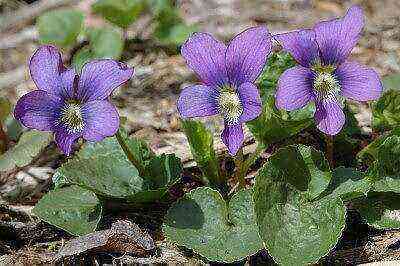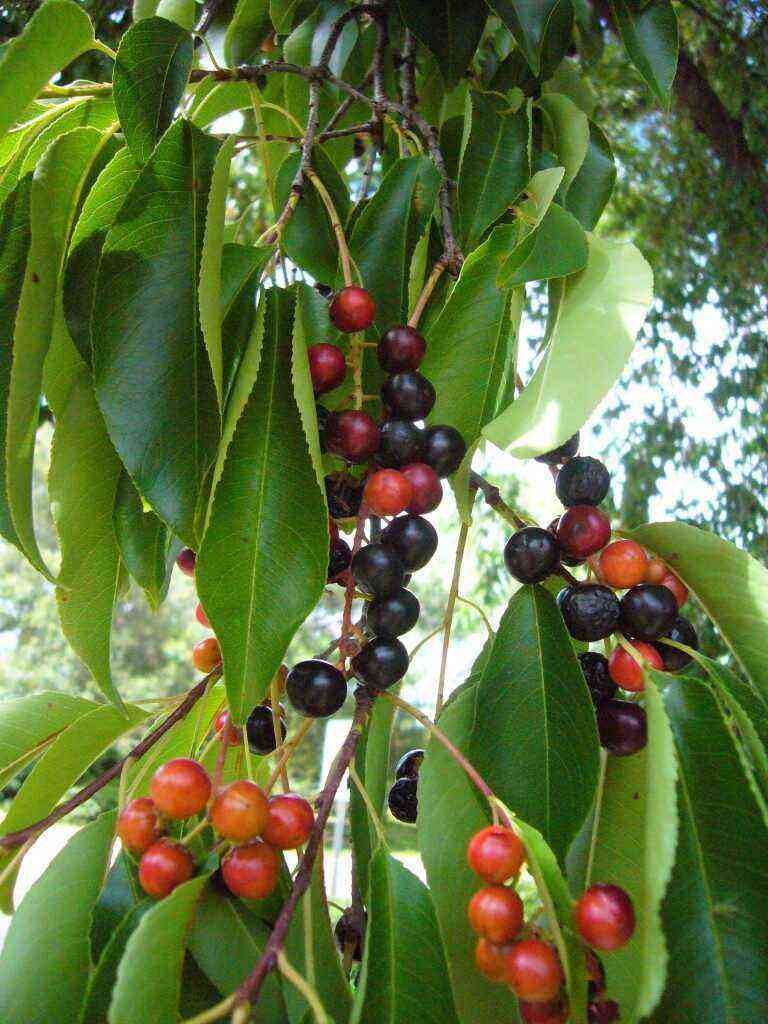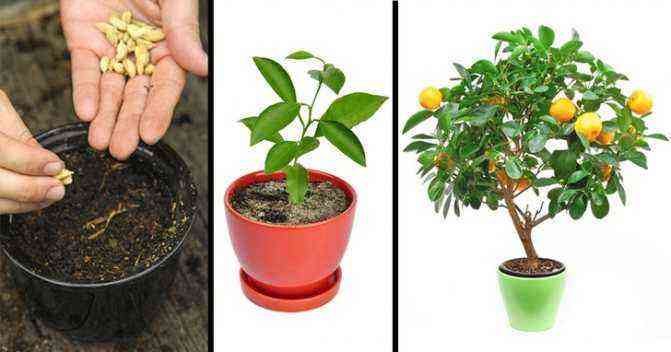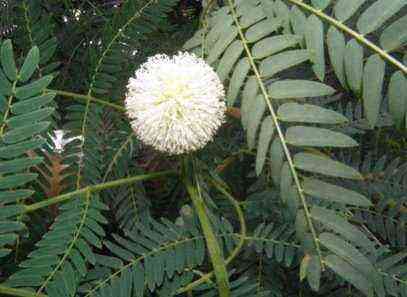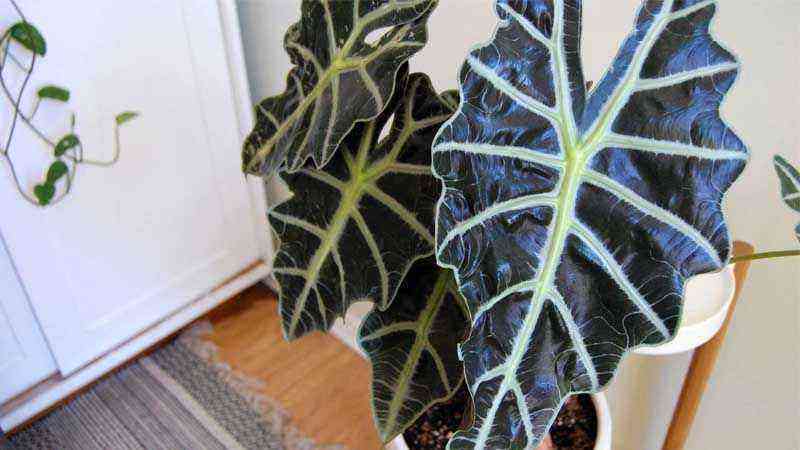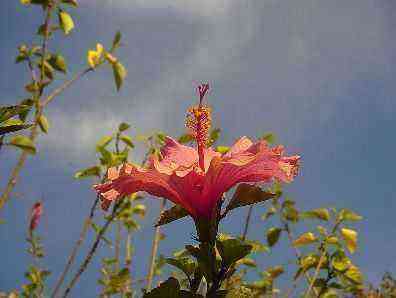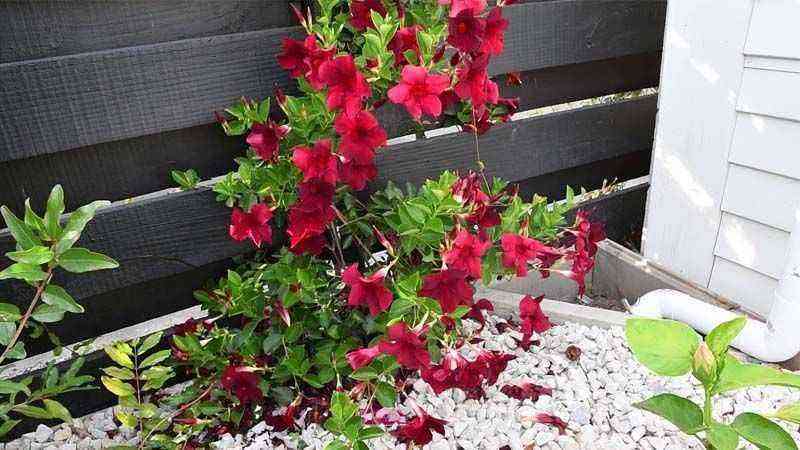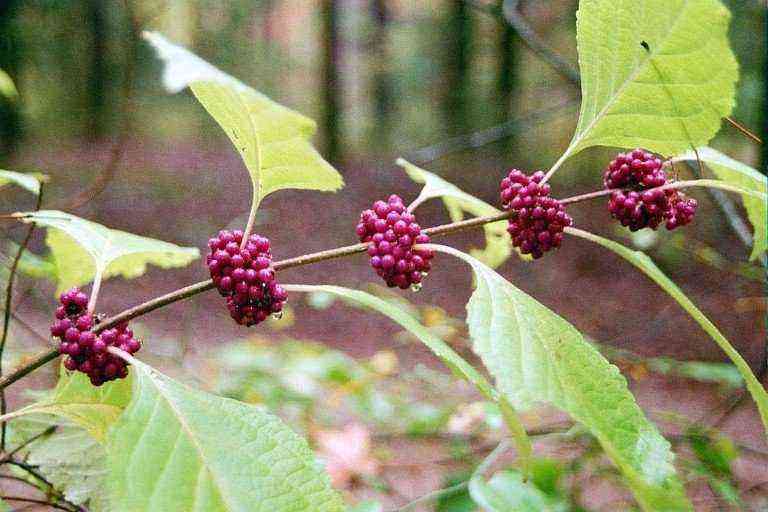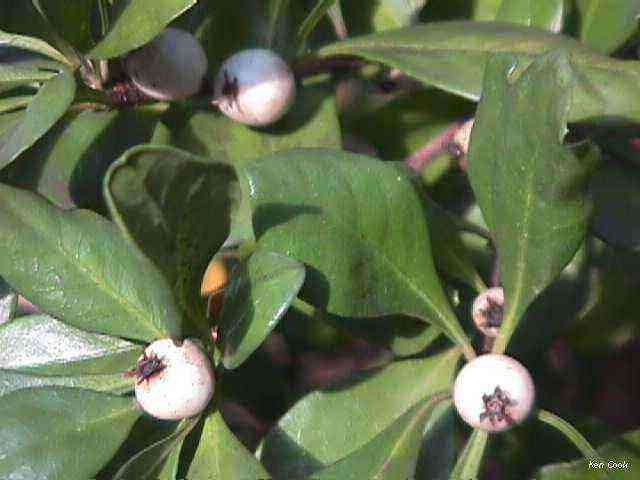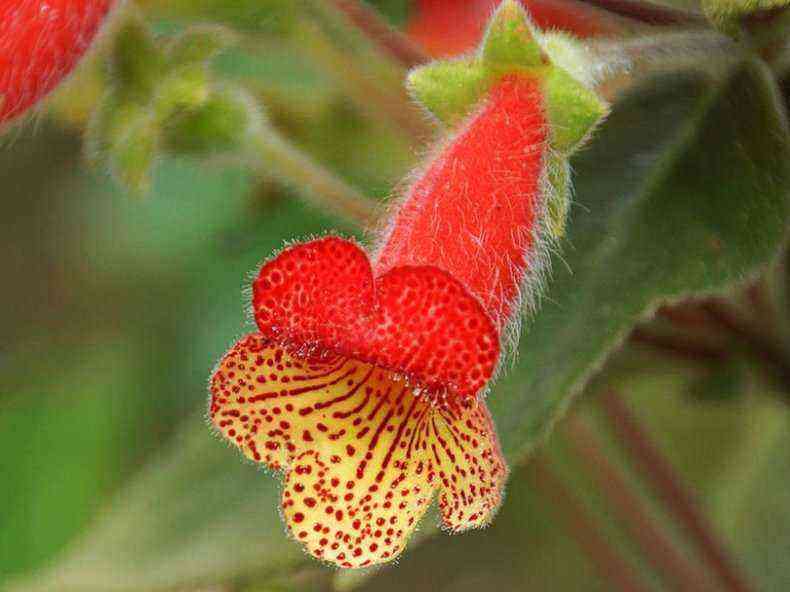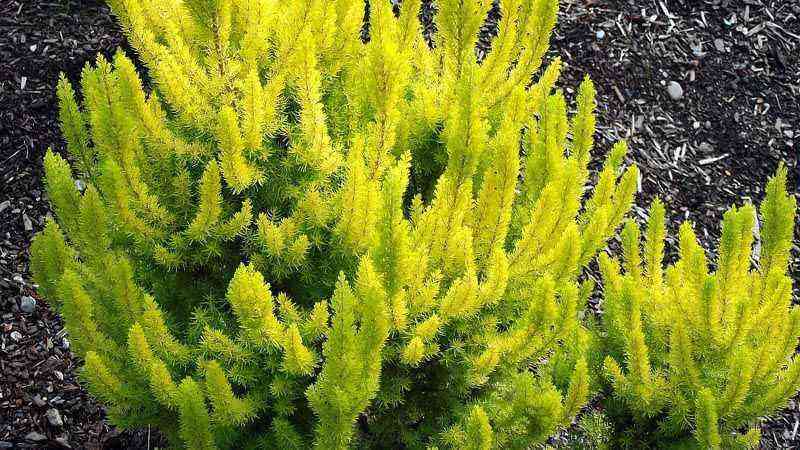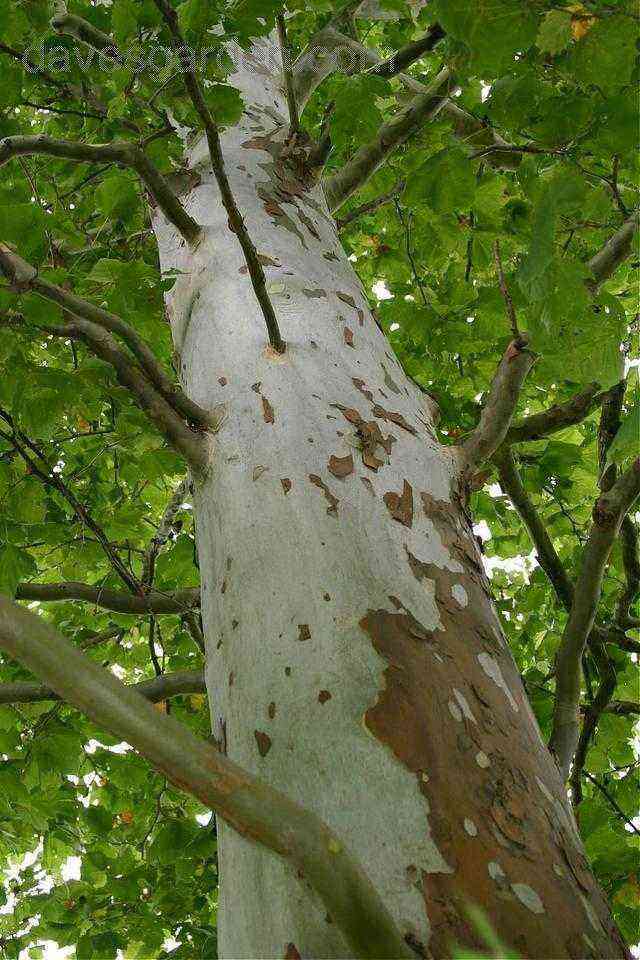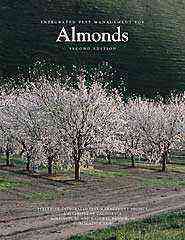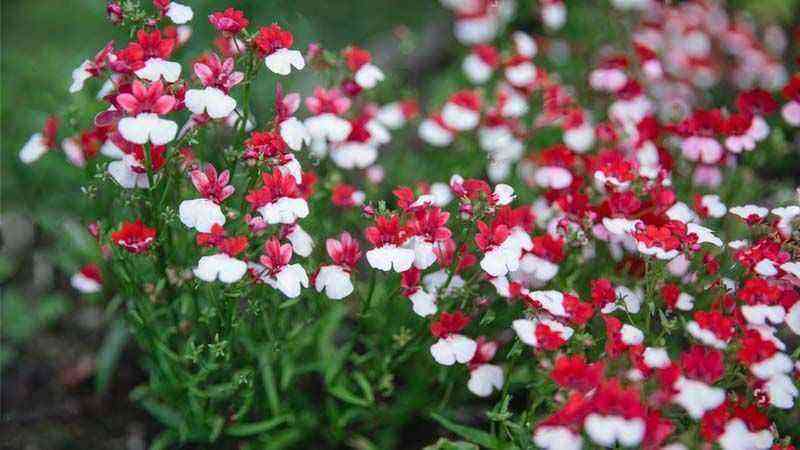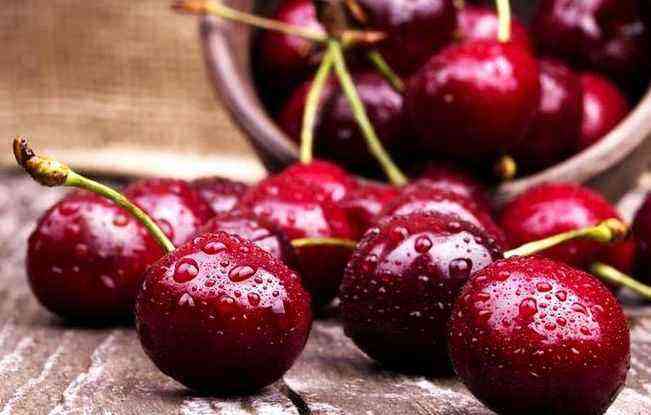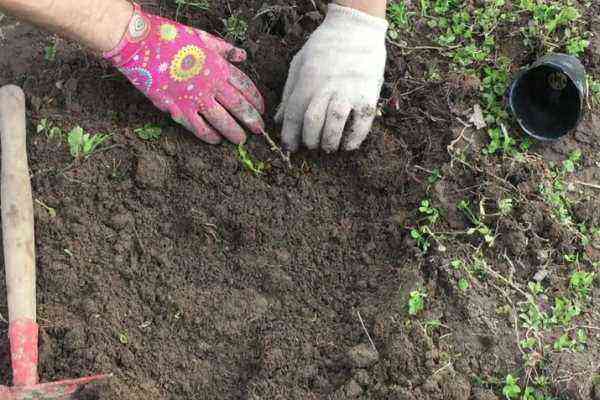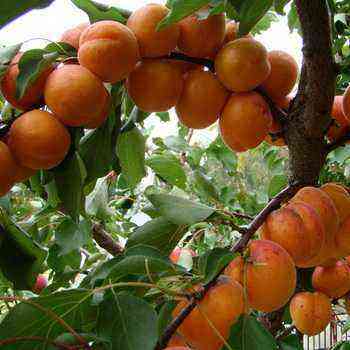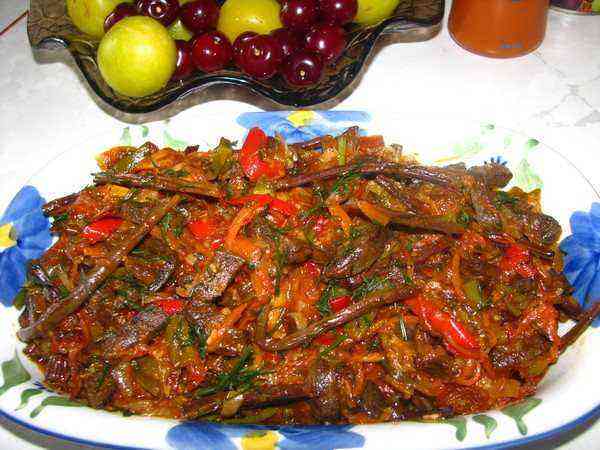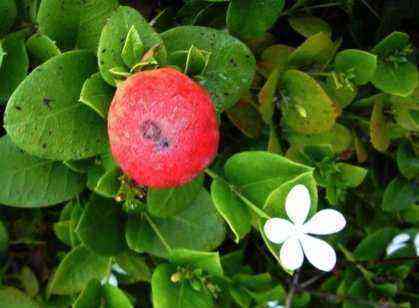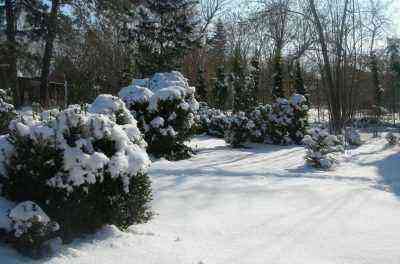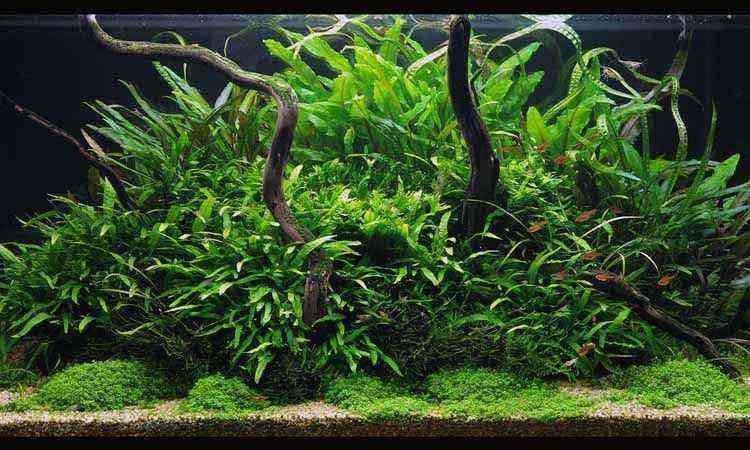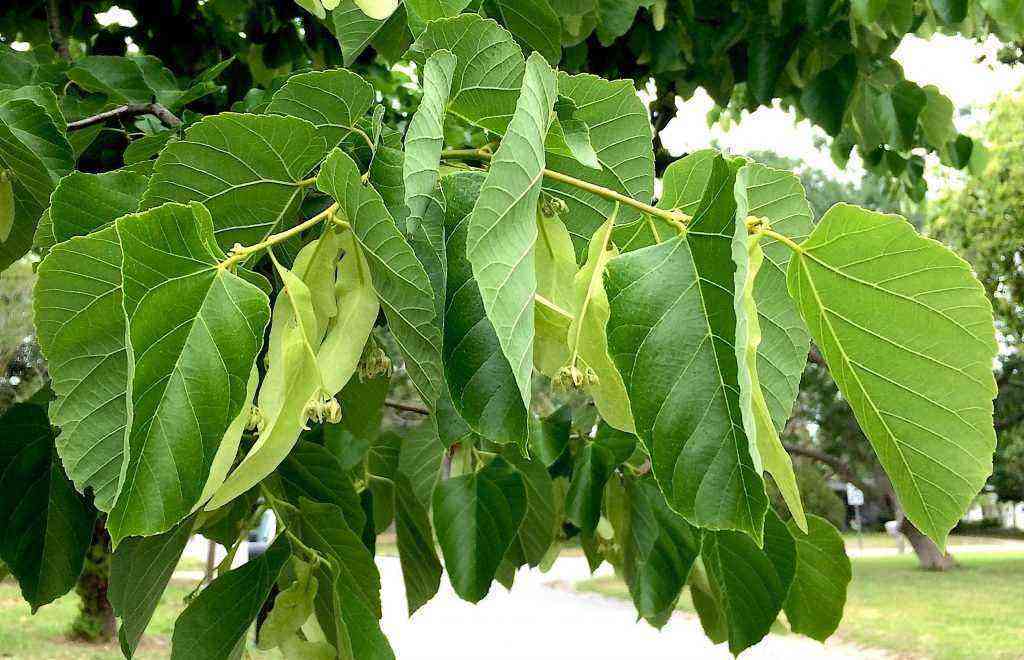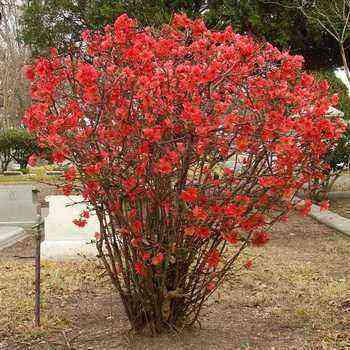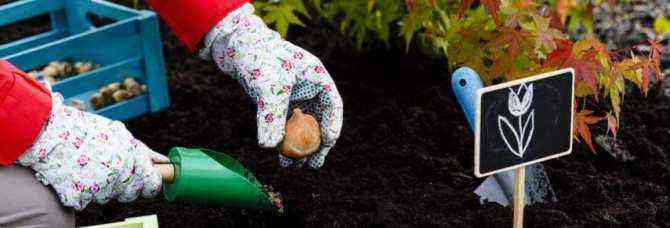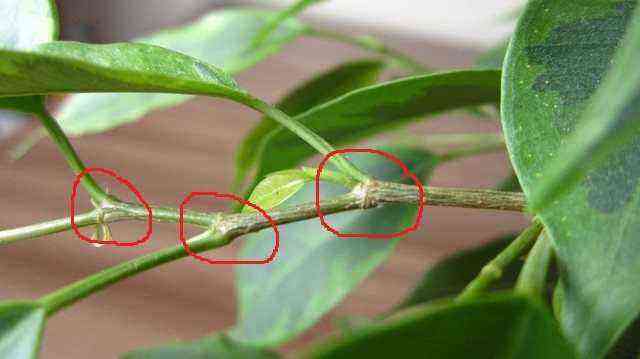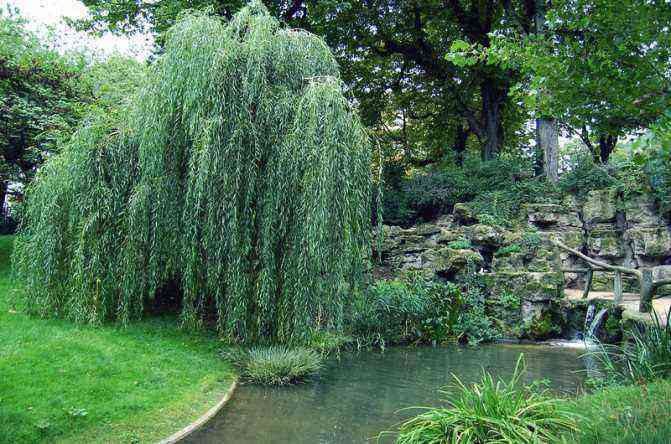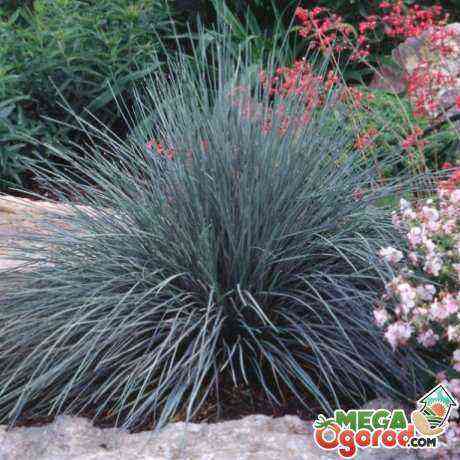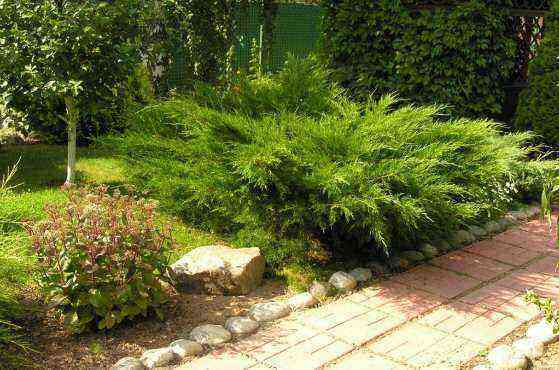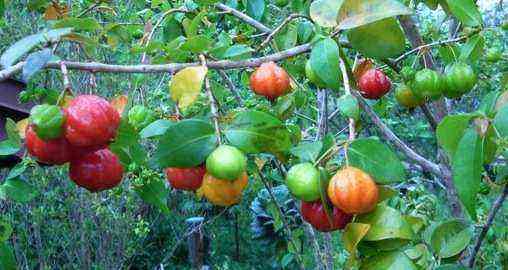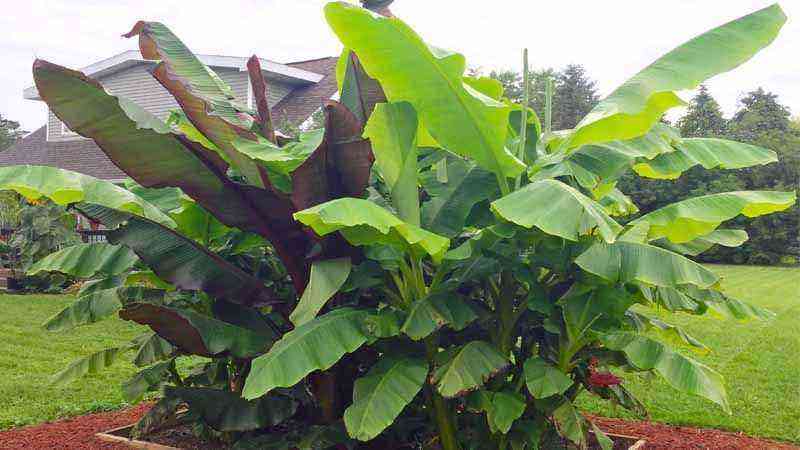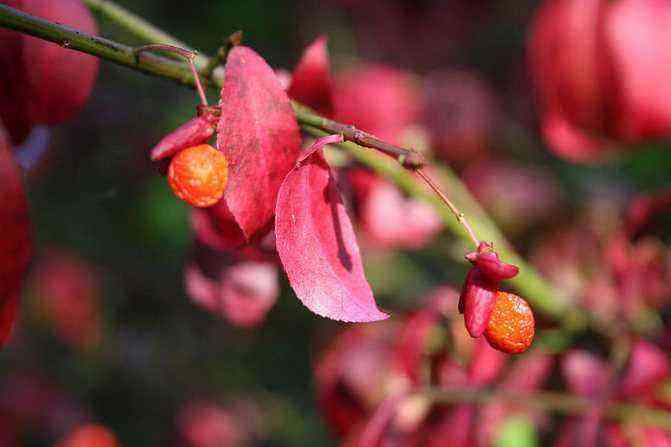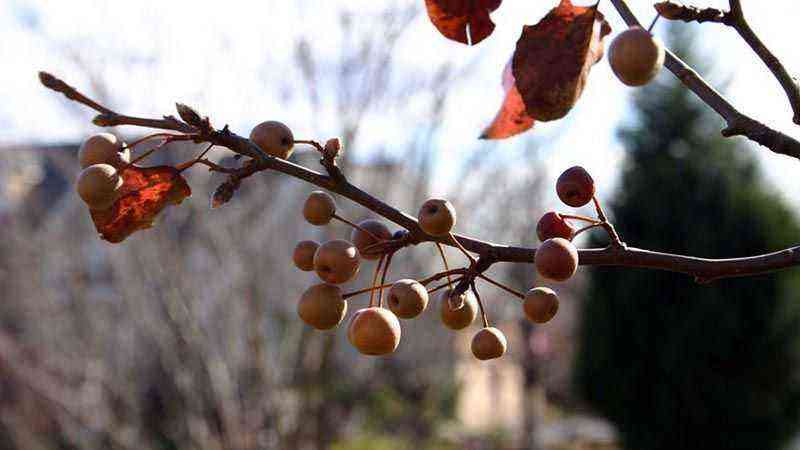Junipers (Juniperus) are old-timers of the terrestrial flora: they appeared about 50 million years ago. Modern species of junipers are very diverse, among them there are giants up to 30 m tall and elfin trees, barely 10-15 cm rising from the ground. About 70 species are known, of which about a dozen of the most decorative and resistant species are grown in Russia.
- Juniper virginiana (Juniperus virginiana) Hetz (J. pfitzeriana Hetzii, Juniperus virginiana Hetz), Glauca, Gray Owl, Tripartita
- Agnieszka, Andorra Compact, Blue Chip (Blue Moon), Golden Carpet, Glauca, Gray Pearl, Icee Blue (Momber), Jade River, Variegata, Wiltonii
- Blue Alps, Expansa Variegata, Kuriwao Gold, Spartan, Torulosa VarieМata (Kaizuka Variegata), Plumosa Aurea (J. pfitzeriana Plumosa Aurea), Stricta
- Arnold, Tablet, Golden Showers, Depressa Aurea, Green Carpet, Нornibrookii, Horstmann, Meyer, Repanda, Suecica Aurea
- Blue Arrow, Blue Heaven, Moonglow, Skyrocket (Sky Rocket)
- Allgold (All Gold), Blue Pacific, Schlager
- Blue and Gold (Blue Gold), Carbery Gold, Gold Coast, Old Gold, Pfitzeriana Aurea, Pfitzeriana Glauca
- Blue Sweden, Blue flourish, Holger, Meyers
- Juniper seedlings: selection rules
Juniper virginiana (Juniperus virginiana)
The plant is native to North America. In culture since 1664. The needles are scaly, needle-like on young plants and on the lower branches of adult specimens. The cones are blue-black, round.
Juniper virginiana Hetz (J. pfitzeriana Hetzii, Juniperus virginiana Hetz)
Shrub up to 2-3 m in height and more than 3 m in diameter. The crown is spreading. The needles are gray-blue, turning brown in winter.
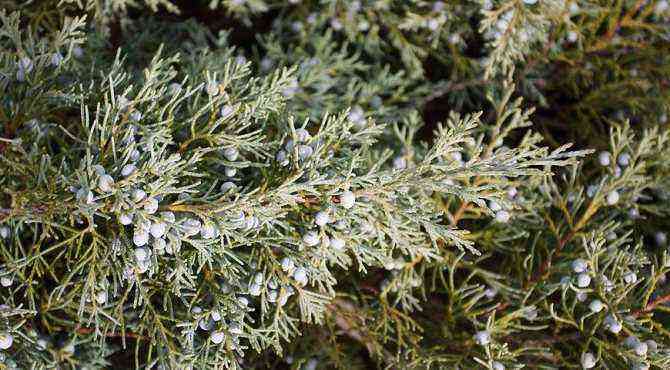
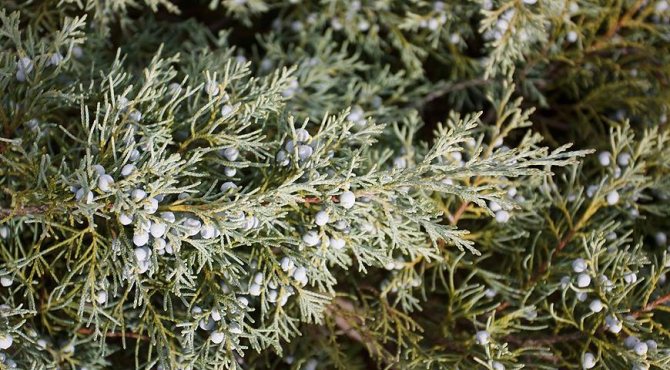
Juniper virginiana Hetz (J. pfitzeriana Hetzii, Juniperus virginiana Hetz)
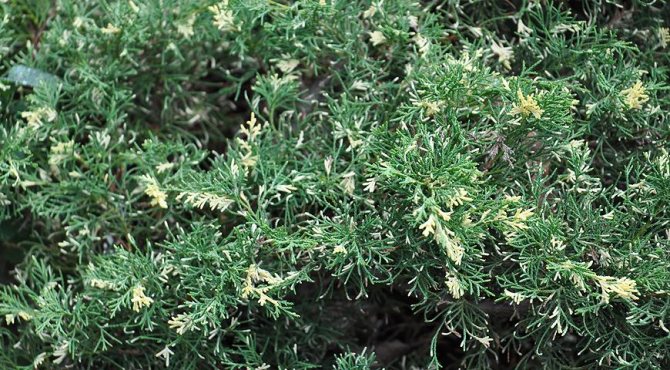
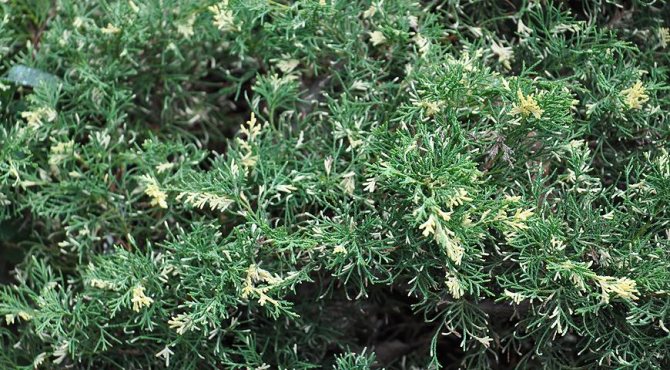
Juniper Virginia Hetz Variegata
Juniper Virginia Glauca
Columnar tree, up to 5–8 m in height and up to 2–5 m in diameter, with a dense crown. The needles are greenish-gray.
Juniper Virginia Gray Owl
Shrub up to 10 m high at 1,5 years of age and more than 3 m in diameter. The needles are gray-green or gray-blue, in winter with a bluish-bronze tint.

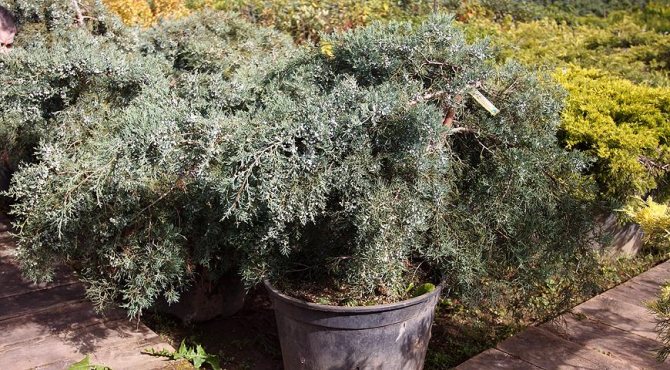
Juniper Virginia Gray Owl
Juniper Virginia Tripartita
Shrub up to 1,5–2 m high. Needles are acicular, bluish above, green below.
Juniper Juniperus indoor
Juniperus Juniper
Juniper belongs to the cypress family. In the Northern Hemisphere, it is represented by small trees or shrubs, is well known primarily to gardeners, and does not often appear on our windowsills. And nevertheless, some junipers make interesting indoor plants. Chinese juniper is best suited for keeping on windowsills, since many of its varieties winter well at a temperature of 16-18 ° C.
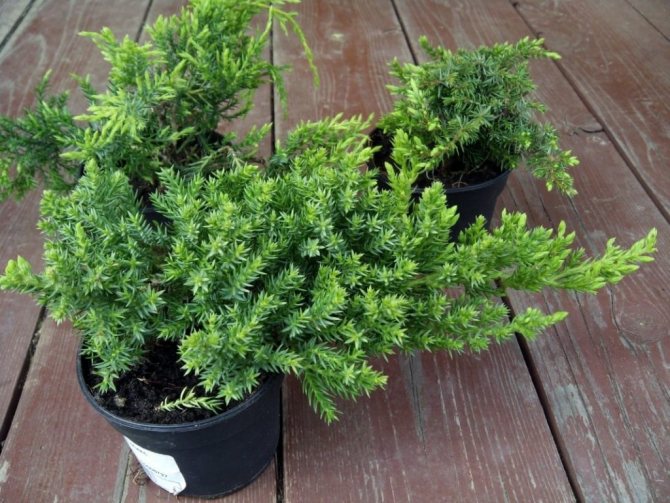

Particular attention should be paid to the Chinese juniper ‘Yaponika’, a stable and rather unpretentious plant. It is a small, highly branched tree with a beautiful reddish-brown trunk, short needles arranged in a spiral on the branches. This variety of juniper, like some of its other species, has two types of needles: needle-like protruding on young plants and scaly, strongly adhering to adults. The needles on the growth of the current year are painted in a silvery-bluish color, the older ones turn green, then dry up and turn red.

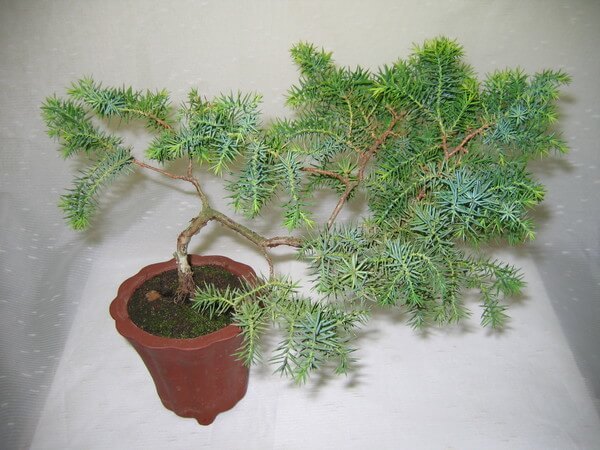
Indoor juniper care:
It is possible to recommend growing a juniper at home to those flower growers who have at their disposal a loggia with a winter temperature of at least 10 ° C. In a room with a winter temperature of 20-22 ° C, juniper can be placed on the windowsill near the balcony, from the side of the frame that opens for ventilation. It is good if there are blackout curtains hanging on the windows. When they are pulled, a buffer zone with a cooler temperature is formed near the window.
location: Juniper requires a well-lit area. From late April to mid-October, if temperature conditions permit, it is best to keep it outdoors (balcony, loggia). If there is no balcony, an east or west window sill will do, but it is important that the window is opened frequently and the flow of fresh air flows directly onto the plant. In winter, the amount of light is unimportant only with a cool content, because the juniper is at rest. At a temperature of 18 ° C, you need to light the plant additionally.
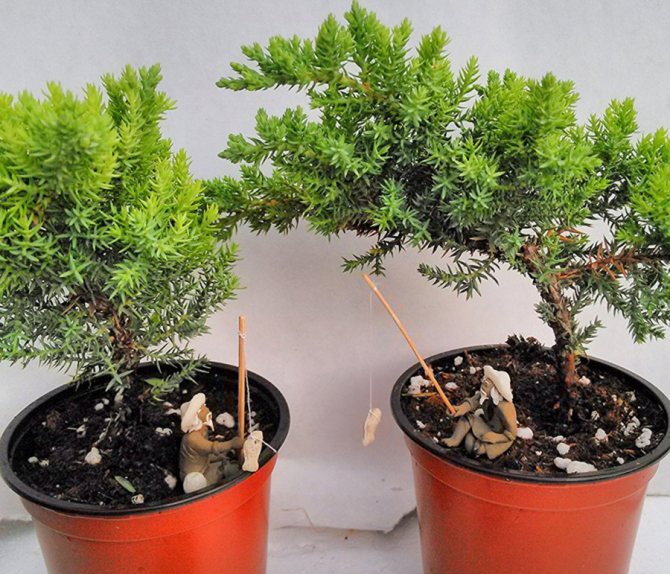
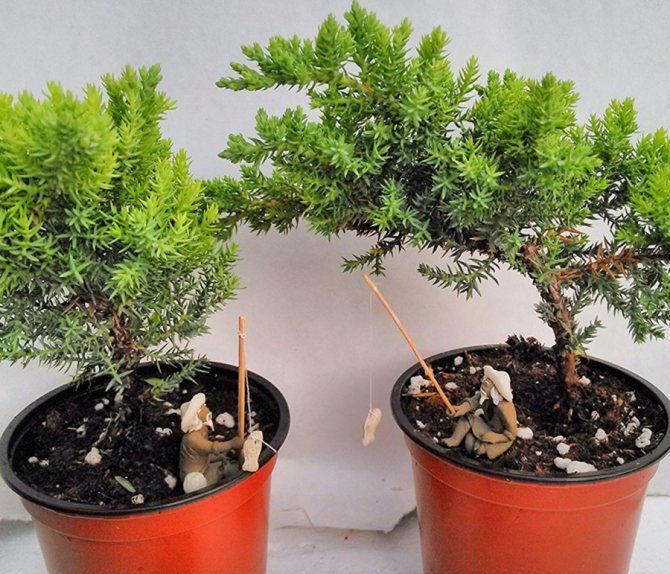
Temperature: Chinese juniper tolerates from 3 to 30 ° С, but optimally in summer 16-22 ° С, in winter 12-16 ° С. Low positive temperatures (3-5 ° C) are allowed in autumn, at night, if the plant has spent all summer on the balcony and feels great. If in winter a juniper stands at the balcony door, and outside -20 ° C, you need to set it aside when opening the door: despite the love of coolness, it can be severely damaged by the flow of icy air, and then the tips of the needles will turn red.
Watering: Although junipers are considered drought tolerant crops, it is best not to take risks when growing in a pot. In winter, regular and moderate watering is observed after the top layer of the substrate dries, in summer – from moderate to abundant, without stagnation of moisture in the pan.
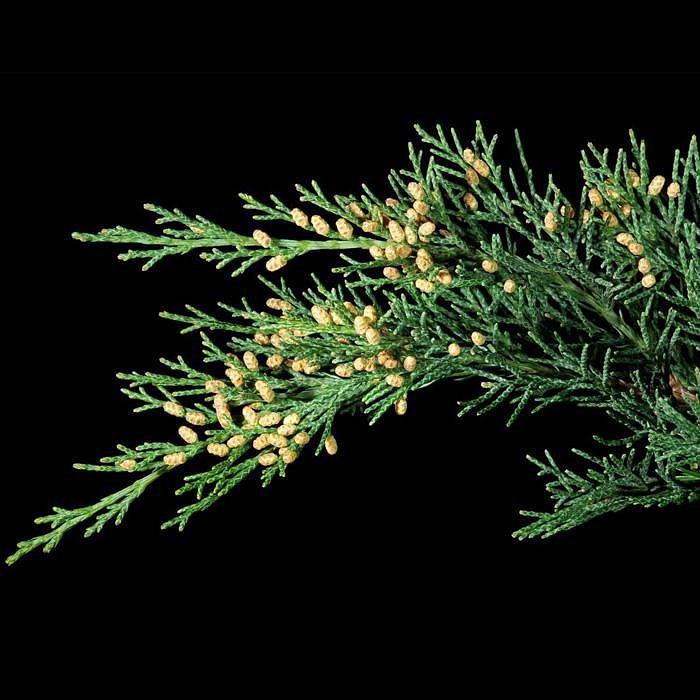
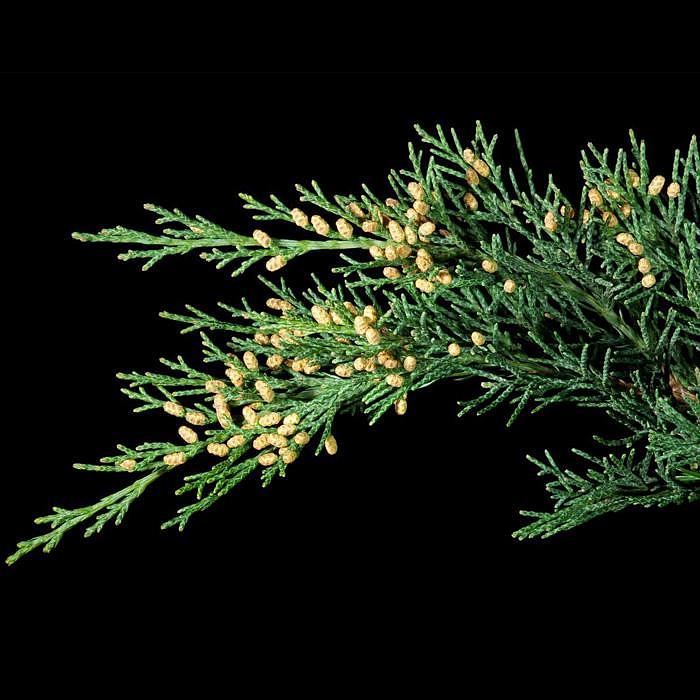
Transfer: The root system of the juniper is large, but superficial. Therefore, it is better to take a pot wide, but not too low, with a rounded bottom. Bonsai bowls are preferable from an aesthetic point of view, but do not forget that you will have to water more often and more attention will be required. The soil mixture should be quite dense, contain turf, coniferous, leafy soil, sand, some clay and peat. Rooted cuttings slowly develop the root system, so they will need the first transplant only when the size of the plant has approximately doubled. Subsequently, the transplant is done quite rarely, no more than once every 2 years, when it becomes noticeable that the size of the plant clearly does not correspond to the parameters of the pot.
Maintaining appearance: In addition to formative pruning and cutting off the tips of the shoots, for better branching, you need to regularly pluck out the old red-colored needles with tweezers. This must be done carefully, because the smallest branches break off easily if they are pulled strongly.
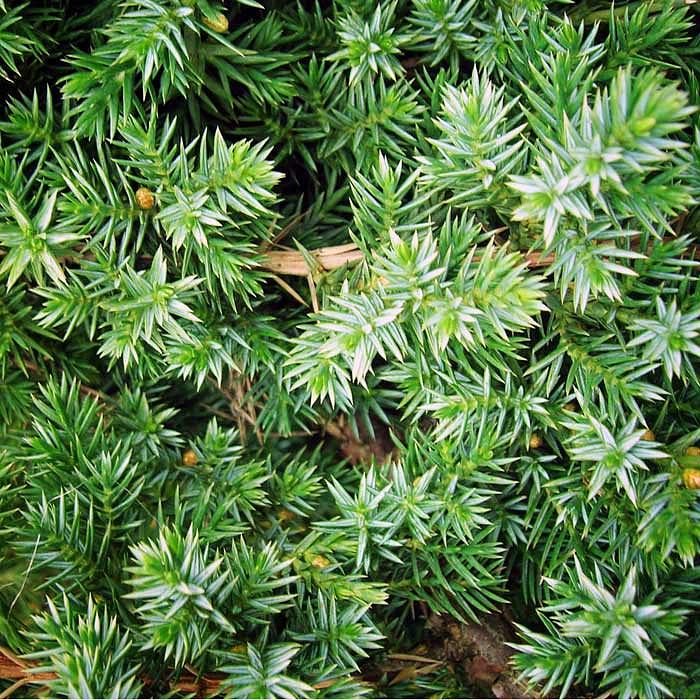

Reproduction: Chinese juniper can be propagated by apical cuttings 10-12 cm in size or slightly larger. In practice, it is best to root the planting material outdoors in summer in the constantly moist soil of a balcony box, in the shade of geraniums and other plants. Root treatment is desirable.
Diseases and pests: It is practically not damaged by pests. Does not tolerate prolonged storage in dark, dry, excessively warm and poorly ventilated rooms. With inaccurate watering and improper planting, the juniper can get sick from both lack and excess of water.
Juniper horizontal, or prostrate (Juniperus horizontalis)
A creeping, undersized shrub with long branches, native to North America. The needles are scaly, in culture they are also needle-like. The cones are spherical, black.
The varieties are often similar to each other. Creeping forms can be grafted onto a low stem.
Juniper horizontal Agnieszka
Polish slow-growing dwarf variety: at the age of 10, 0,3 m high and 1,5 m in diameter. The needles are very small, bluish-green, after frost they acquire a lilac hue.
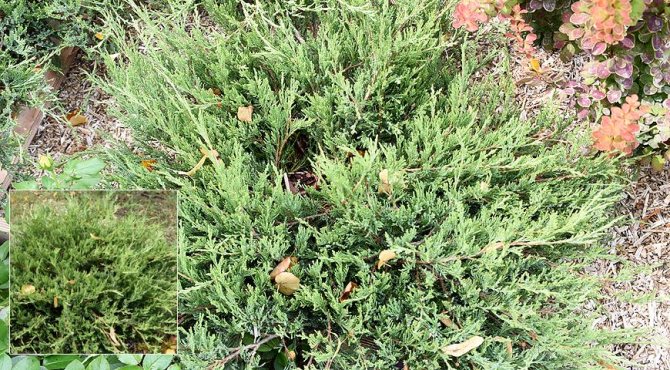

Juniper horizontal Agnieszka
Juniper horizontal Andorra Compact
Slow-growing shrub, with a dense cushion crown, up to 0,4 m high and up to 2 m in diameter. The needles are bluish-green, with a purple tint in winter.
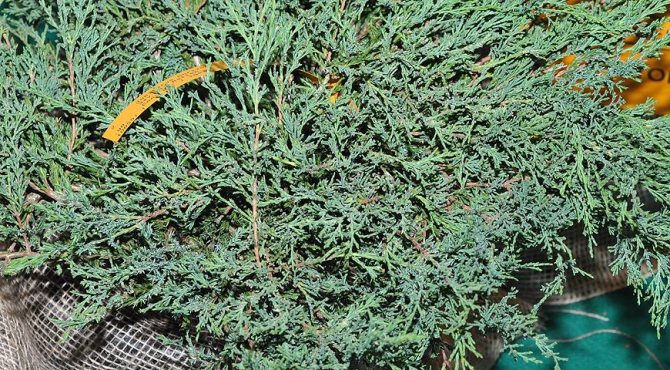
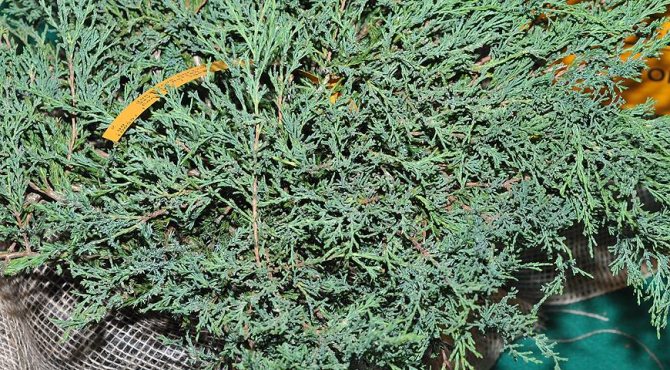
Juniper horizontal Andorra Compact
Juniper horizontal Blue Chip (Blue Moon)
Shrub with an irregularly shaped crown and short erect shoots, up to 0,3 m high. The needles are silvery-blue.
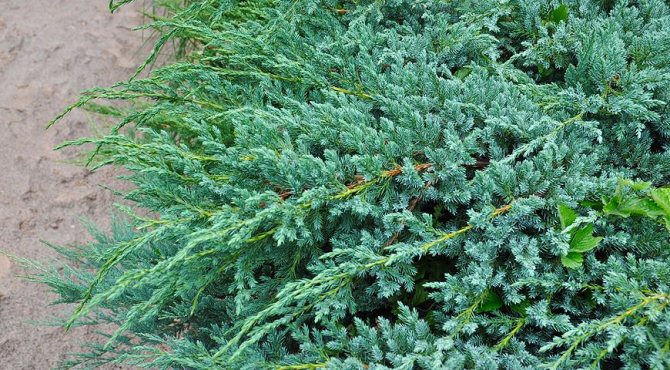

Juniper horizontal Blue Chip (Blue Moon)
Juniper horizontal Golden Carpet
Slow-growing shrub, with a dense crown, up to 0,1 m in height and up to 1 m in diameter. The needles are yellowish-green, bright yellow at the ends of young shoots. Sports by Wiltonii.

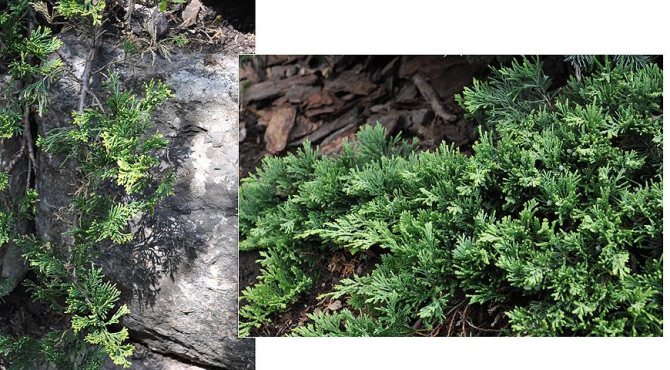
Juniper horizontal Golden Carpet
Juniper horizontal Glauca
Ground cover plant up to 0,3 m high and up to 2 m in diameter! Creeping shoots adjacent to the ground. Needles from steel blue to blue-green. Suitable for stony and heather gardens, stone retaining walls.

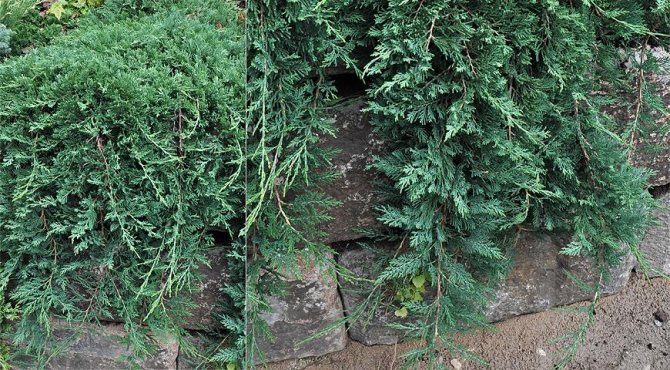
Juniper horizontal Glauca
Juniper horizontal Gray Pearl
Shrub with vertically growing branches, up to 0,2–0,4 m in height and up to 1 m (1,5 m) in diameter. The needles are blue-green or bluish-steel, bronze in winter.
Juniper horizontal Icee Blue (Momber)
Dwarf form, with a dense spreading crown, up to 0,1 m in height and up to 1,5–2 m in diameter. The needles are silvery-blue.
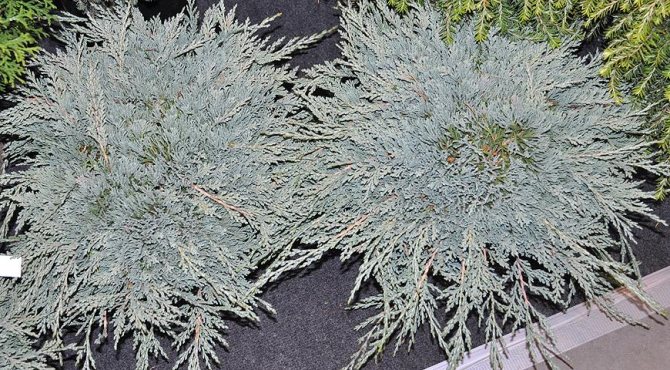
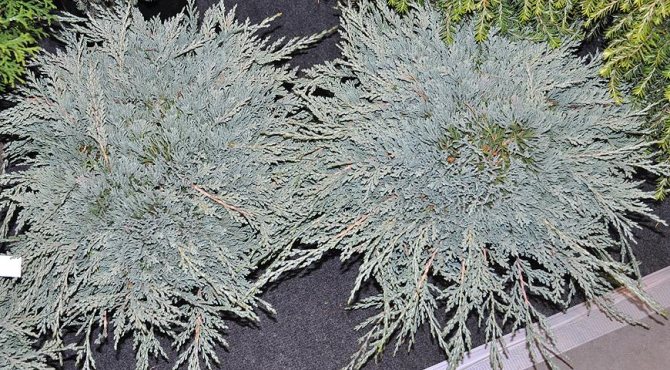
Juniper horizontal Icee Blue (Momber)
Juniper horizontal Jade River
Dense shrub, up to 0,4 m in height and up to 2,5 m in diameter. The needles are silvery-blue, with a purple tint in winter.
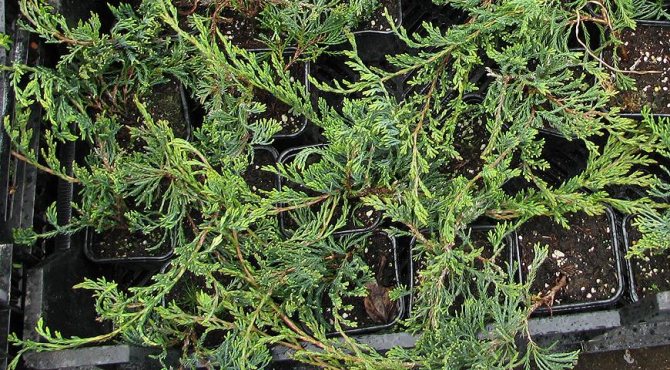
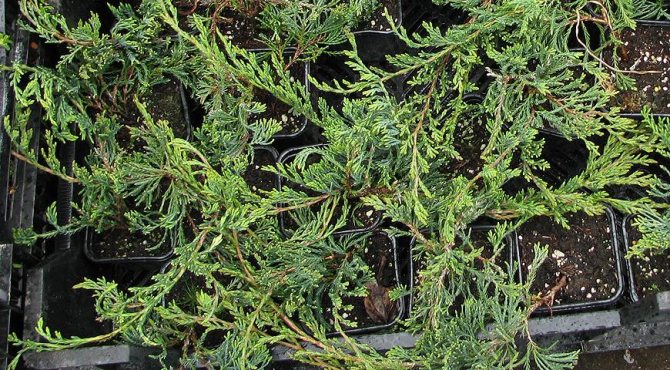
Juniper horizontal Jade River
Juniper horizontal Prince of Wales
Slow-growing shrub, up to 0,3 m high and up to 2,5 m in diameter. The needles are green, bronze in winter.

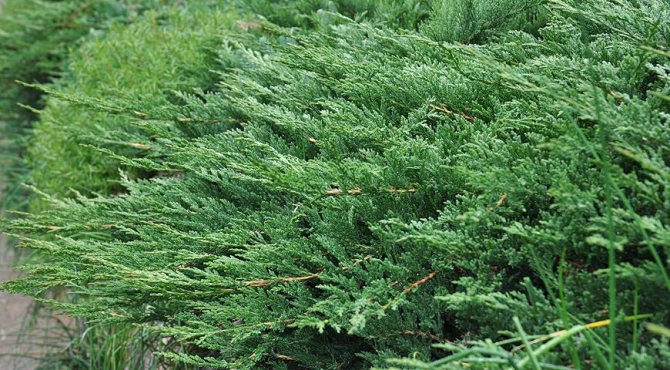
Juniper horizontal Prince of Wales
Juniper horizontal Variegata
Shrub up to 0,2 m high and up to 1,5–2 m in diameter. The needles are blue-green with rare creamy patches.
Juniper horizontal Wiltonii
Slow-growing densely branched shrub, up to 0,1 m high and up to 2 m in diameter. The needles are silvery-blue.
Chinese juniper varieties
Breeders have bred a fairly large number of varieties of this crop, but the following are considered the most popular:
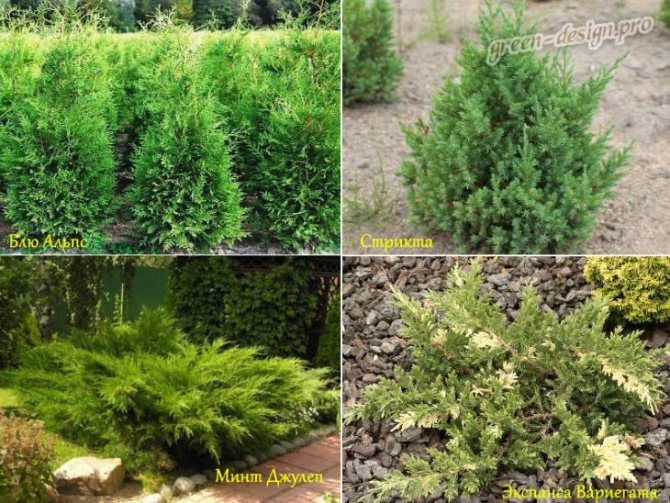

Popular shrub varieties
- Juniper Chinese Blue Alps (Juniperus chinensis Blue Alps). A fast-growing variety of shrubby ephedra, reaching 2-3m in height and up to 2m in width. It stands out for its unusual gray-blue needles.
- Juniper Chinese Stricta (Juniperus chinensis Stricta). Shrub, has a crown in the form of a cone, branches are dense, directed upwards. Height – up to 250 cm. The needles have a greenish-blue tint, the ephedra develops rather slowly – up to 20 cm per year. Prefers only sunny areas for planting.
- M. Chinese Mint Julep (Juniperus chinensis `Mint Julep`)… Reaches 200 cm in height, the crown grows 350 cm in width. Shoots resemble wide arcs.
- M. Chinese Expansa Variegata (Juniperus chinensis Expansa Variegata). A miniature representative of the species, its height is no more than 40 cm. The peculiarity of the bush is that it develops not upwards, but to the sides. The needles are usually green-blue in color with a chaotic arrangement of cream-colored shoots. The variety is often used in the formation of Japanese gardens.
Daurian Juniper (Juniperus davurica)
It grows naturally in the Far East, in Eastern Siberia, in the north of Mongolia and China. Slow-growing creeping shrub with ascending branches, up to 0,5-1 m high. Needles are needle-like, scaly at the ends of the shoots, bright green in summer, turns brown by winter.
Round cones with a diameter of 5–6 mm, dark blue with a bluish bloom. Winter hardiness is high. Rare in culture.
Juniper Daurian Leningrad
The most famous variety of Daurian juniper. The needles are green, olive-brown in winter.
Juniper Cossack (Juniperus sabina)
In nature, it grows on the slopes of the mountains of Crimea, the Caucasus, Mongolia, Central and Western Europe. Shrub up to 1,5 m high and up to 5 m wide, rarely erect shrub or tree.
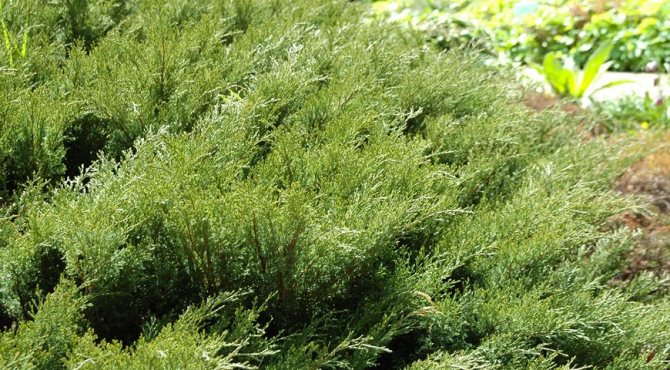
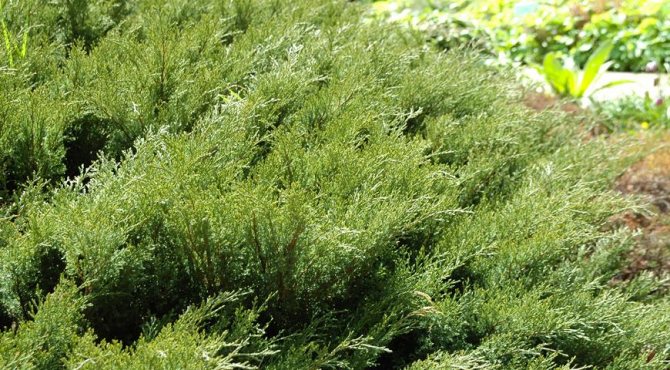
Juniperus Cossack
Rounded cones are brown-black with a bluish bloom. It has been known in culture since 1580.
Juniper Cossack Variegata
Creeping shrub, up to 0,6–1 m in height and up to 1,5–2 m in diameter. Gray-green needles with cream strokes.

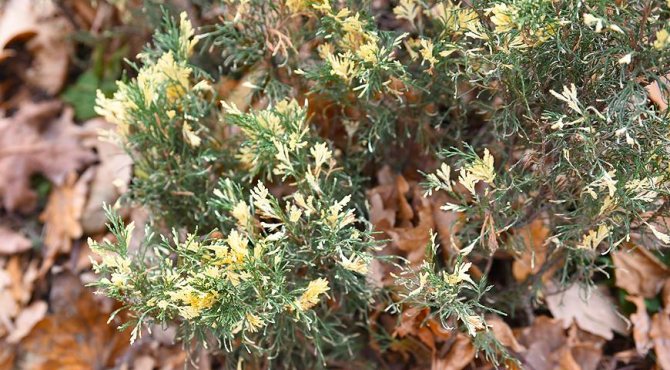
Juniper Cossack Variegata
Juniperus Chinese (Juniperus chinensis)
It grows naturally in China, Mongolia and Korea. Most often, a creeping shrub with dark green, predominantly scaly needles. The cones are almost oval, dark blue, almost black.
Juniper Chinese Blue Alps
Erect, slow-growing shrub, up to 2,5–4 m in height and 2 m in diameter, with a compact dense crown and hanging shoots. The needles are bluish-green above, silvery below. Sunburn.
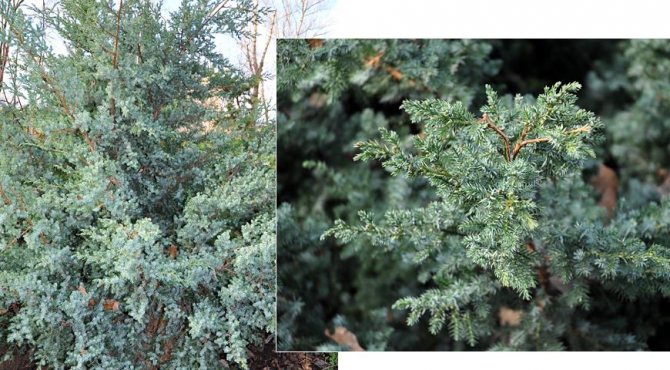
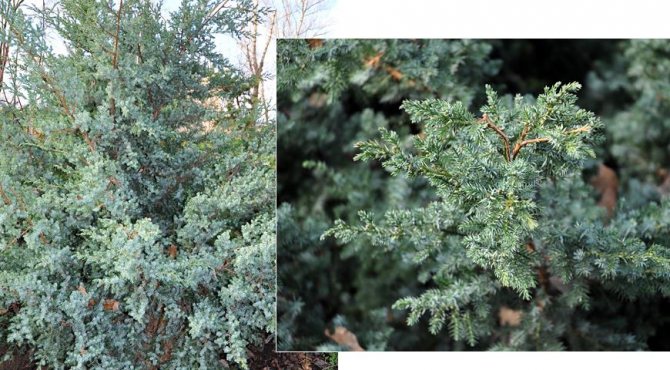
Juniper Chinese Blue Alps
Juniper Chinese Expansa Variegata
Shrub at 10 years of age, about 0,3 m in height and 1 m in diameter. The needles are green, the tips of the shoots are white-cream, in winter with a bronze tint.
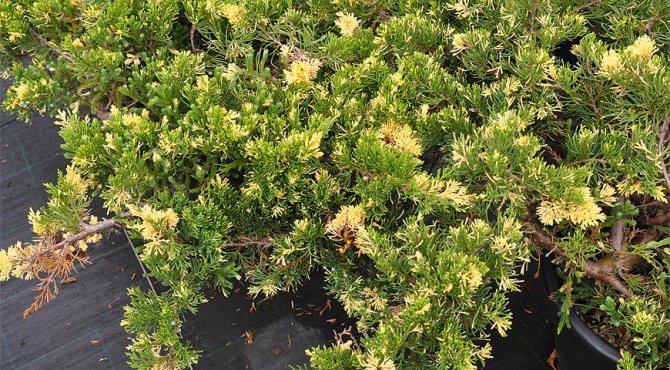

Juniper Chinese Expansa Variegata
Juniper Chinese Kuriwao Gold
A shrub with a spreading spherical crown, at the age of 10, up to 1,5 m high and up to 2 m in diameter. Young needles are yellowish-green, mature green.
Juniper Chinese Spartan
Fast-growing shrub, up to 3-5 m high, with a columnar crown, which eventually becomes wide-pyramidal. The needles are green.
Juniper Chinese Spartan
Juniper Chinese Torulosa VarieMata (Kaizuka Variegata)
Slow-growing shrub, at the age of 10, up to 0,9 m high and 0,6 m wide. The needles are blue-green with creamy white blotches. In a sunny place, the variegation is more pronounced.
Juniper Chinese Plumosa Aurea (J. pfitzeriana Plumosa Aurea)
Erect shrub, 2-3 m high and up to 3-4 m in diameter, with an uneven crown. The needles are yellow, bronze-yellow in winter.
Juniper Chinese Stricta
Slow-growing dwarf tree, by the age of 10, up to 1,5 m high and 0,5 m in diameter. The crown is conical, the shoots grow vertically, the needles are green-blue.
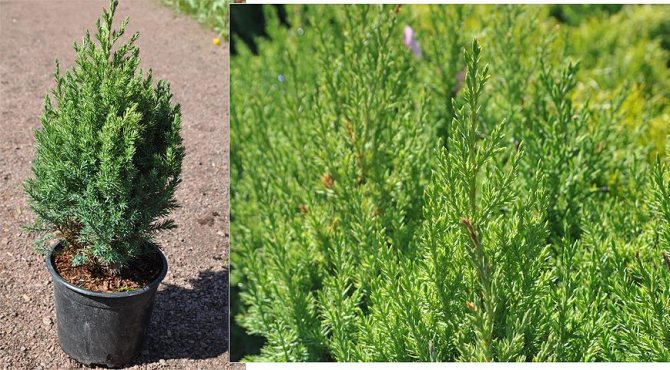
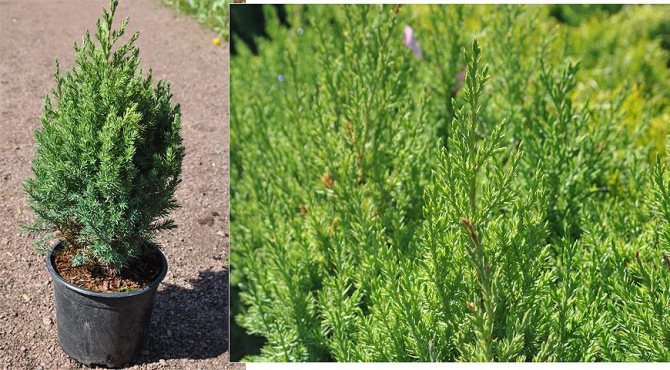
Juniper Chinese Stricta
Description Juniper Chinese Stricta (Juniperus chinensis Stricta) – a shrub with a conical crown and dense vertically growing branches. Reaches up to 2,5 m in height and 1,5 m in diameter, grows slowly: Annual growth of 20 cm.Lives up to 100 years. The needles are bluish-green, needle-like, prickly, gray-blue in winter. The cones are small, round, purple-brown, numerous. Juniper Chinese Strikta is used in single and group plantings for landscaping local gardens, heather or rocky landscapes, as well as a hedge. Decorated plantings in containers are found in the city. It goes well with barberry, cotoneaster, dogwood, honeysuckle, erica and mountain pine.
| Description: | dense cone-shaped crown, reaches a height of 2 m at the age of 10, up to 1,5 m in diameter. The final height is 2-3 m. |
| Needles: | soft, green, with a blue tint. It gets more gray in winter. |
| The soil: | undemanding to soils. Grows well in fresh, fertile, well-drained soils. |
| Shine: | sun, partial shade. |
| Frost resistance: | frost resistance is average. |
| Application: | single and group plantings, stony, heather gardens, rock gardens. |
Planting and caring for strickta juniper
Juniper is best planted in sunny places, slight shading is allowed. The distance between the planted plants is from 0,5 to 2 m, depending on the size. The planting pit should be 2-3 times larger than the earthen coma and depth, for adult plants up to 70 cm. At the bottom of the pit, a drainage layer of sand or broken brick about 20 cm thick is made. When planting, it is important that the root collar is not buried.
Junipers prefer soil that is slightly acidic to neutral (see Understanding Soil Acidity: Determining and Adjusting pH). The soil mixture is made in a ratio of 2: 1: 1 from peat, sand and turf, respectively. After planting, the plant should be watered abundantly for a week.
In dry summers, it must be watered. Junipers do not tolerate dry air well, so it is advisable to regularly sprinkle. Fertilizers are applied once a year in spring at the end of April or in May. Young plants need shallow loosening.
For the winter, the plants are sprinkled with peat 10 cm thick, and young plants are covered with spruce branches. Columnar varieties can suffer from heavy snowfalls, so in the fall the branches are pressed against the trunk with a ribbon or rope (see Shelter for the winter conifers, Juniper: planting and care, Juniper. Diseases and pests. Treatment).
Juniper lying (Juniperus procumbens)
The plant is native to Japan. Creeping dioecious shrub with open branches, 0,2–0,5 m high, crown diameter up to 2–4 m. The needles are bluish-green. The cones are round, blackish-brown with a pale blue waxy bloom. Can be grafted onto a stem. Used for clipping bonsai.
Juniper lying Nana
Japanese variety. A creeping shrub, with a dense crown up to 0,4 m in height and a crown diameter of up to 1–1,5 m. The needles are bluish-green.
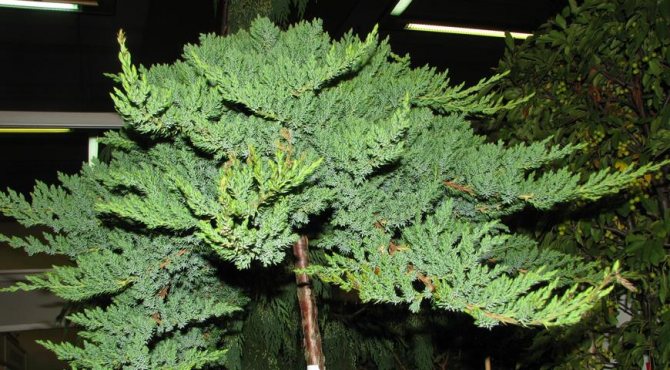
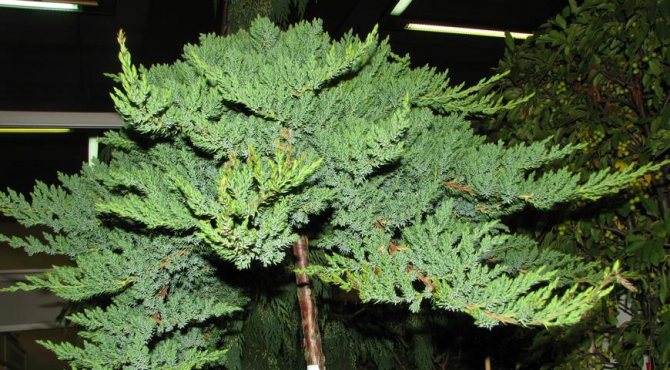
Juniper lying Nana on the trunk
Common juniper (Juniperus communis)
One of the most widespread species, it grows naturally in the forests of Northern and Central Europe, Siberia, East Asia, North Africa and North America. A long-lasting slow-growing tree or shrub. The needles are acicular green, with a waxy bloom. The cones are round, black with a bluish bloom.
Arnold common juniper
Slow-growing compact shrub, up to 3 m high and with a narrow-columnar crown, up to 0,6 m in diameter. The needles are bluish-green.
Common juniper Compressa
Dwarf variety, with a narrow-columnar dense crown, up to 0,8–1 m in height and up to 0,3 m in diameter. The needles are light green.
Juniper ordinary Golden Showers
Slow-growing shrub, up to 1 m high. The needles are golden-yellow, in the second half of summer and autumn – golden-green.
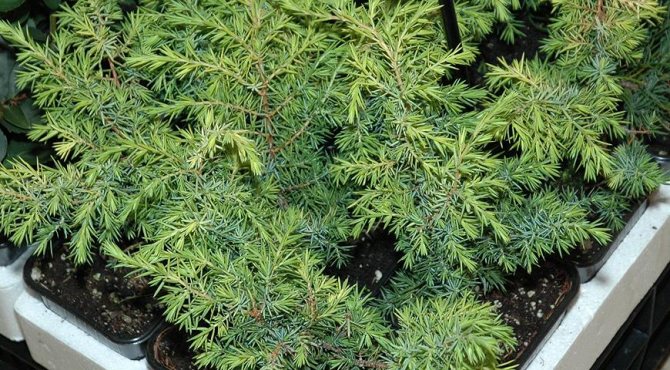
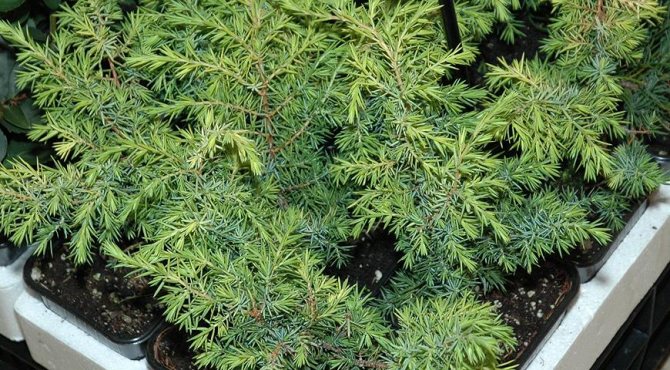
Juniper ordinary Golden Showers
Juniper ordinary Depressa Aurea
Shrub up to 0,6-1 m high and up to 1,5-2 m in diameter. Needles are dark green with yellow young shoots, yellow-brown in autumn.
Common juniper Green Carpet
Slow-growing creeping shrub, up to 0,1 m high and crown diameter up to 1,5–2 m. The needles are light green, soft.
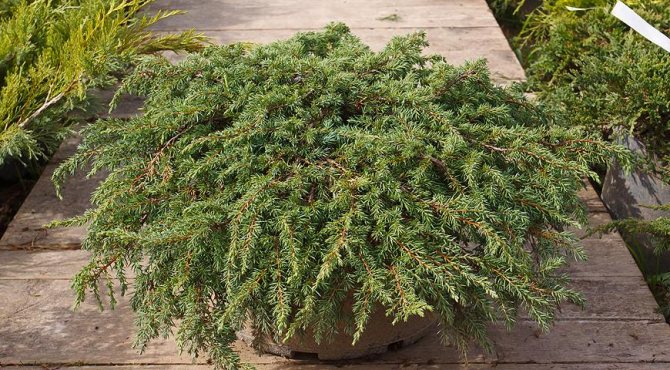
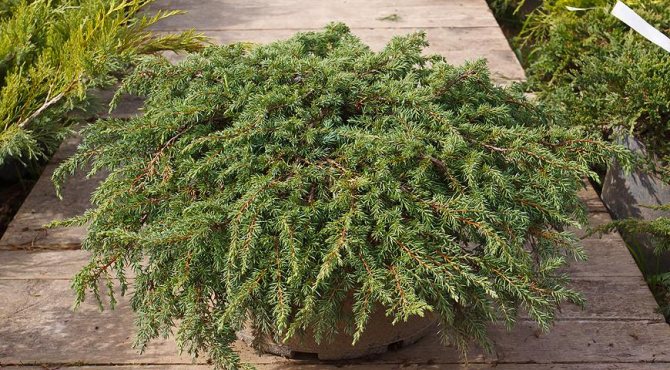
Common juniper Green Carpet
Juniper ordinary Нornibrookii
Slow-growing shrub, up to 0,3-0,5 m high and up to 2-3 m in diameter. The needles are light green with a silvery-white stripe.
Juniper ordinary Horstmann
Shrub with strongly weeping shoots, up to 2,5 m high and up to 2-3 m in diameter. The needles are bluish-green.
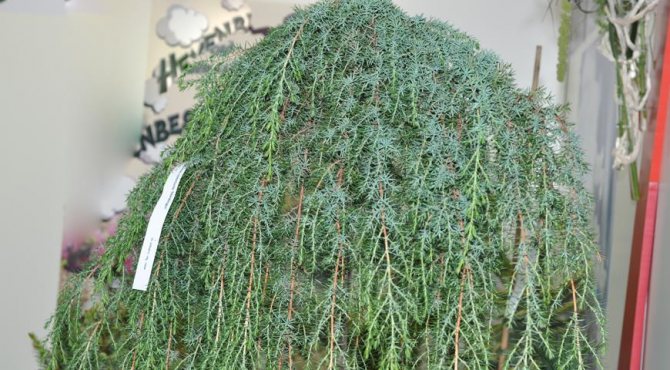
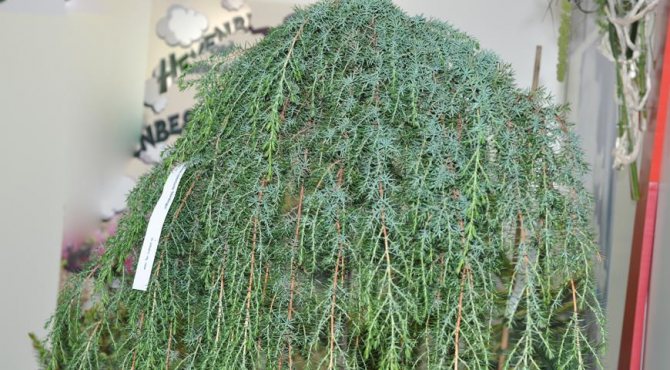
Juniper ordinary Horstmann
Common juniper Meyer
A fast-growing shrub with a pronounced multi-trunk, up to 3 m in height and up to 1,2 m in diameter. The needles are bluish-green.
Common juniper Repanda
Creeping form, up to 0,3-0,5 m high and crown diameter up to 1,5-2,5 m, with a cushion-shaped crown. The needles are dark green with silvery stripes on the upper side, brownish-green in winter.
Common juniper Suecica Aurea
Slow-growing shrub, with a dense columnar crown, up to 2-3 m high. The needles are yellow-green, yellow-brown in winter.
Popular varieties
Many varieties and hybrid forms of Chinese juniper have been developed, differing in the structure of the crown, color of the needles, and resistance to adverse factors.
Some varieties of this coniferous species:
- Blue Alps (‘Blue Alps’) – shrub slow-growing form 3,5–4,7 x 1,8–2,5 m in size. The crown is compact, the shoots hang down a little. The needles are needle-like, up to 1 cm long, hard, prickly, green with a silvery-blue tint. When grown, it is required to protect from burning in February and early spring.
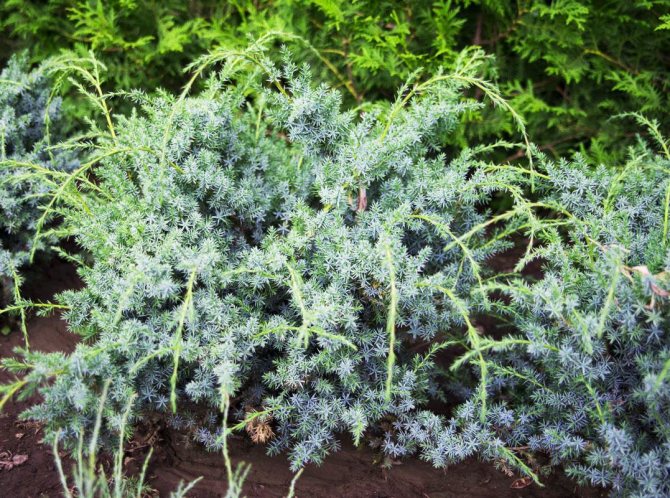
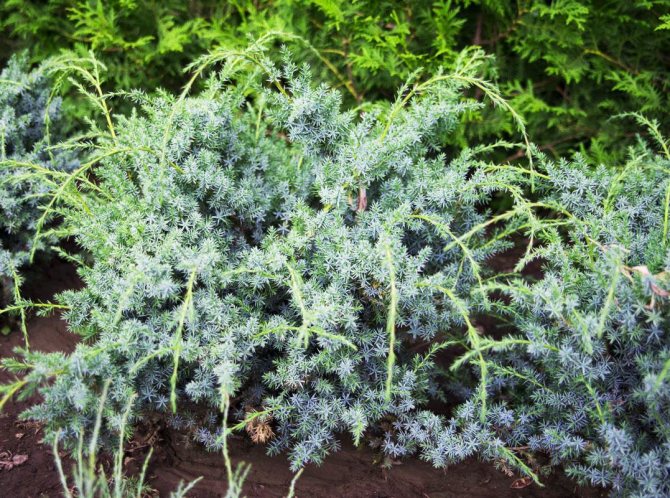
- Expansa Variegata (‘Expansa Variegata’) – a shrub creeping on the ground, growing to a size of 10 x 0,3 m by the age of 1,2. Leaves of two types, bluish tide. Cones with a diameter of 0,5-0,7 cm, change color from light green to black with a bluish tinge. The peculiarity of the variety is in the creamy color of young shoots, giving the bush a variegated color.
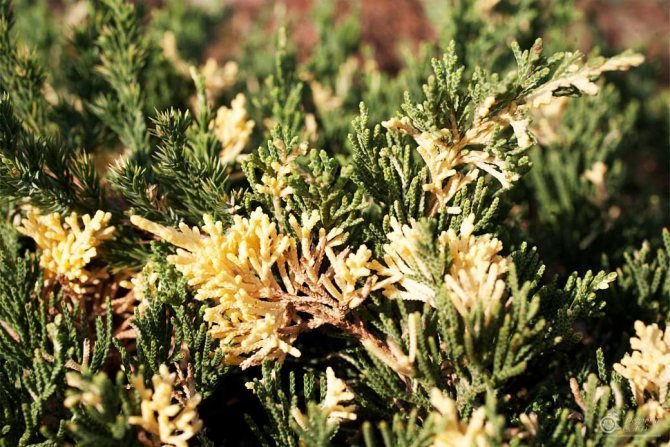
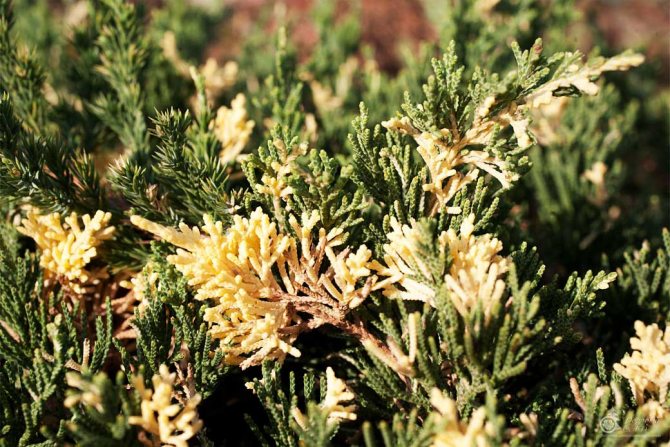
- Stricta – cone-like slow-growing Chinese juniper with tightly spaced straight branches. The approximate parameters of a mature specimen are 2,5 x 1,5 m. The leaves are needle-like, prickly, bluish-green in color, acquire a grayish tint in winter.
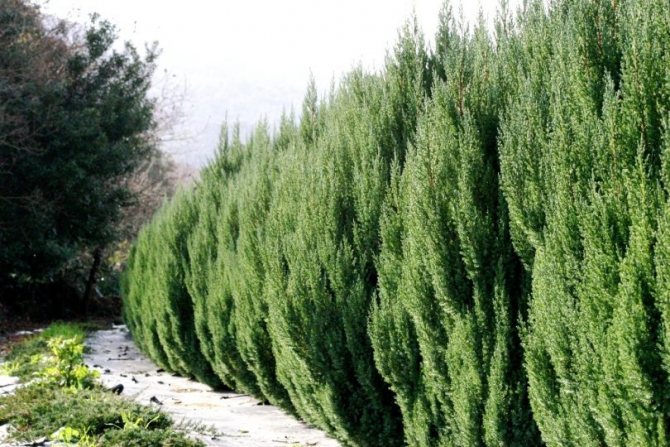

- Obelisk – a variety with an irregular crown, changing shape from a narrow conical to a wide columnar. The needles are prickly, dark green with a bluish tinge.


- Old Gold (‘Old Gold’) – a variety of Dutch selection with a dense squat crown. In adulthood, it reaches the parameters of 1,5 x 3 m. The needles are mainly scaly, golden-yellow in color. The variety is suitable for container growing.
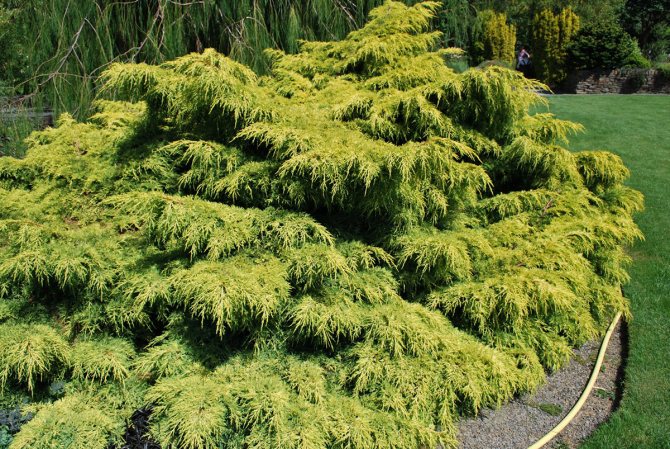
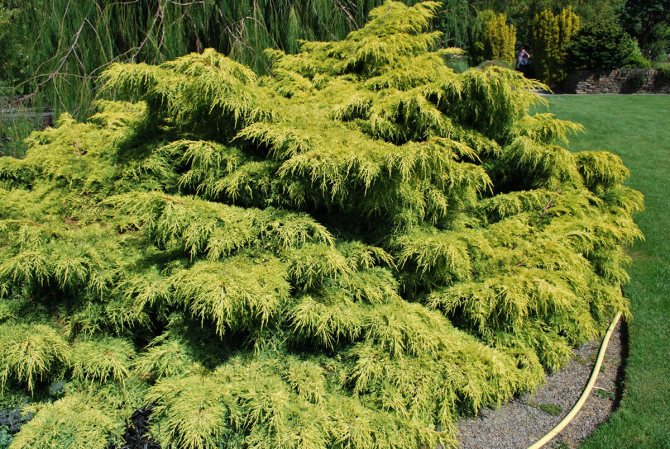
- Spartan (‘Spartan’) – a juniper with a dense pyramid-shaped crown, branches directed upwards; grows to a size of 6×2 m. Most of the needles are scaly, green in color. The annual growth is 15 cm, the variety lends itself to forming.

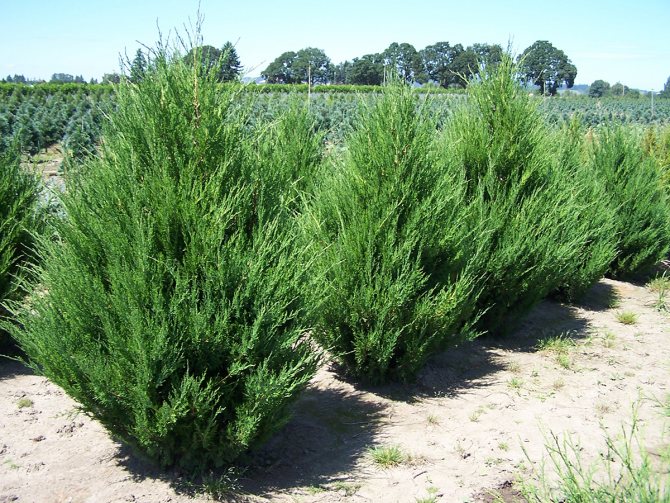
Rocky juniper (Juniperus scopulorum)
The species grows naturally on the slopes of the Rocky Mountains of North America at an altitude of 2000 m above sea level. The tree is usually multi-stemmed. The needles are dark green, mainly scaly, needle-like, up to 12 mm long. Round cones are dark blue with a bluish bloom.
Rocky juniper Blue Arrow
Narrow-columnar shrub with a dense crown, at the age of 10, up to 2 m high. The needles are bluish-gray, scaly.

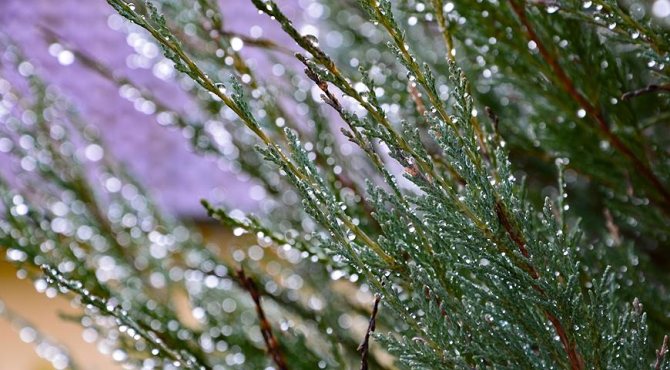
Rocky juniper Blue Arrow
Rocky juniper Blue Heaven
Shrub up to 2–2,5 m in height and up to 1,5 m in diameter, with a uniform conical crown. The needles are bluish-green.
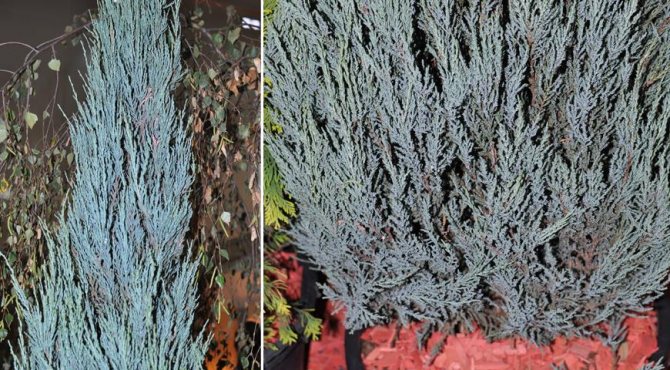
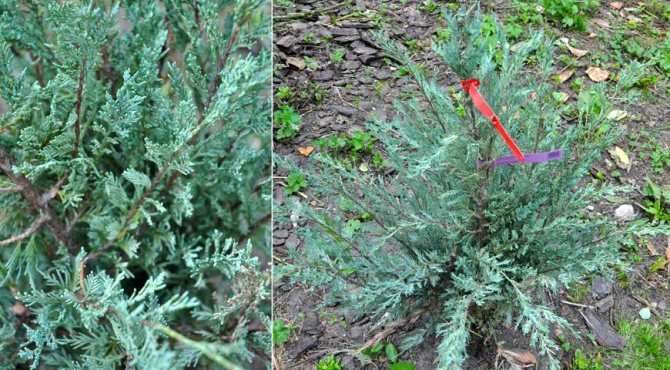
Rocky juniper Blue Heaven
Rocky juniper Moonglow
Shrub up to 3–5 m in height and up to 1 m in diameter. The needles are silvery-blue. There is a variegated Moonglow Variegated with a creamy white color.

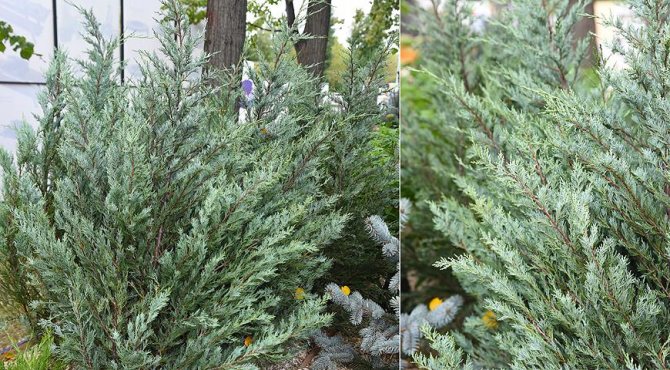
Rocky juniper Moonglow
Juniper rocky Skyrocket (Sky Rocket)
Popular variety. Narrow-columnar shrub, up to 6 m high (at 10 years of age 2,5 m) and up to 0,8-1 m in diameter. The needles are grayish-blue.

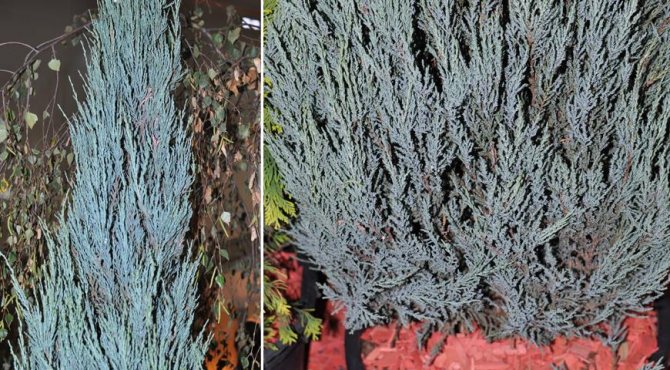
Juniper rocky Skyrocket (Sky Rocket)
Description of the species
The Latin name of the Cossack juniper is Juniperus sabina. Outwardly, it is a shrub form creeping along the surface of the earth, up to 1,5 m high. The plant rapidly grows in the surrounding area, forming dense thickets. Sometimes among the representatives there are trees up to 4 m with curved trunks. The bark exfoliates in thin slices and is colored reddish brown.
One specimen always has 2 types of needles – needle and scale-like. The needles are soft, erect, pointed, 0,4-0,6 cm long, with a bluish-green upper surface, with a clearly visible vein in the middle. With age, the needles take on the appearance of tiled scales. The leaves on the branches last up to 3 years. The culture is dioecious, the cones are looking down, 0,5-0,7 cm in size, brownish-black, covered with a bluish bloom. The shape of the two-seeded fruits is round-oval. Seed material ripens in the fall and spring of the following year.
On a note! The Cossack variety of junipers differs from others in a specific, pronounced smell that appears when rubbing needles or twigs in hands.
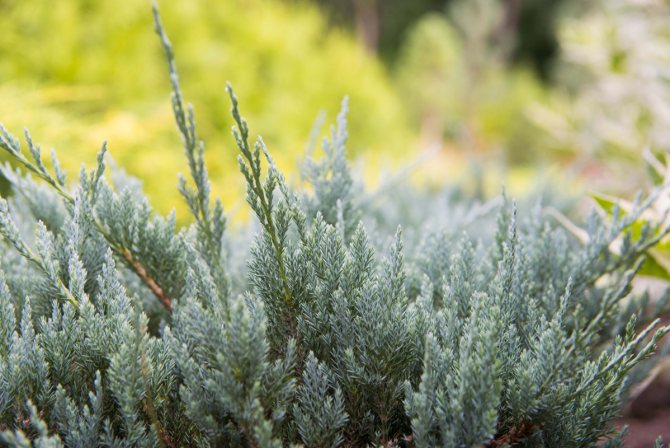

One specimen always has 2 types of needles – needle and scale-like.
Species characteristics:
- drought tolerance;
- brightness;
- winter hardiness;
- low demand for the composition and nutritional value of the soil;
- the ability to endure gas pollution and smoke pollution in cities;
- possession of soil-protective qualities.
The wood is quite soft, but at the same time strong, fine-grained, it can be used in some branches of the woodworking industry. The essential oil of young shoots of the Cossack variety is added to products to protect woolen items from moth damage. Preparations from various parts of the plant in pharmacology, homeopathy and cosmetology are mainly produced for external use. In landscape design, the view decorates the slopes, slopes, rocky hills, lawns, rockeries, forest edges.
Distribution area
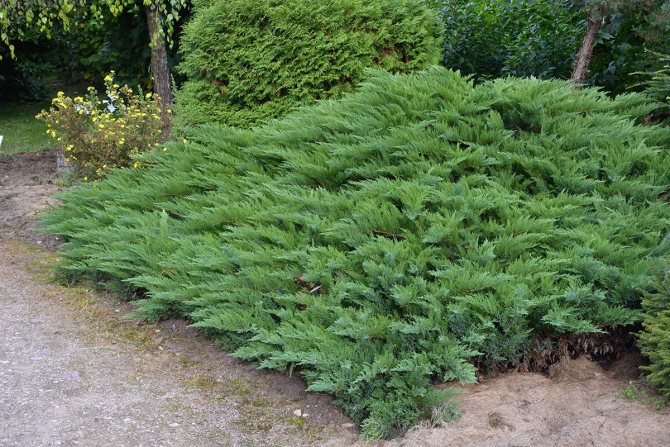
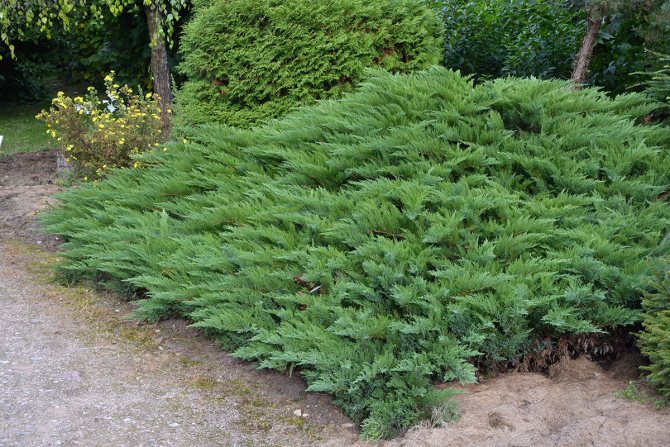
The species grows in forests and groves of the steppe zone, on rocky mountainous terrain, sandy hills.
In its natural habitat, the Cossack juniper is found in Asia Minor and Southeast Asia, South and Central Europe, in the Caucasus. In Russia, it is distributed mainly in the Urals, Siberia, Primorye. The species grows in forests and groves of the steppe zone, on rocky mountainous terrain, sandy hills. From the lower mountain belt it rises to 1000-2300 m above sea level, forming densely planted massifs on the upper tier.
Coastal or crowded juniper (Juniperus conferta)
It grows naturally in Japan and Sakhalin. A creeping shrub with very long branches rising at the ends. The needles are dense, light bluish-green, very prickly. The cones are dark blue with a bluish bloom.
Juniper coastal Allgold (All Gold)
Slow-growing form, with yellow needles, turning green in the shade, up to 0,2 m in height and up to 1 m in diameter.
Juniper Coastal Blue Pacific
A fast-growing form, up to 0,3–0,4 m in height and up to 1 m in diameter. The needles are bluish-green. Can be grafted onto a stem.
Juniper coastal Schlager
Squat, spreading shrub up to 0,3 m high and up to 1 m in diameter. The needles are long, prickly, light green in color.
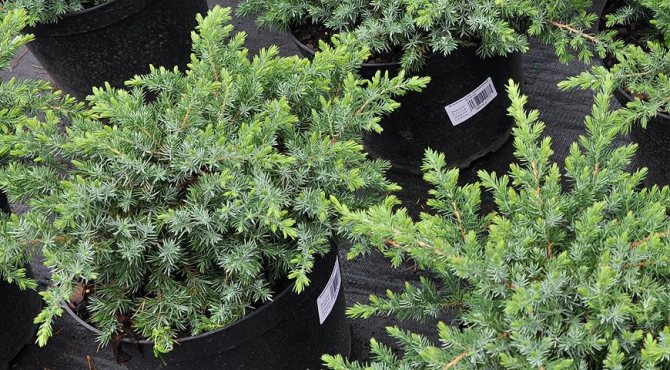
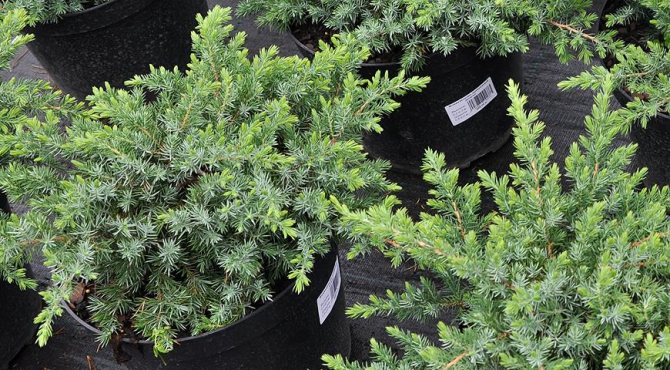
Juniper coastal Schlager
Juniper Pfitzer (Fitzer), or medium (Juniperus × pftzeriana)
A hybrid of Chinese and Cossack junipers. The most widespread and popular group of junipers in the world. Shrub up to 2 m high, with a spreading crown. The needles are scaly and needle-like. It should be noted that in severe winters in the Moscow region, many varieties have noticeable damage. Preferably a sheltered landing site.
Pfitzer Juniper or Medium Blue and Gold (Blue Gold)
Slow-growing shrub, up to 1 m in height and up to 1,5 m in diameter. The needles are bluish-green with golden-yellow blotches.

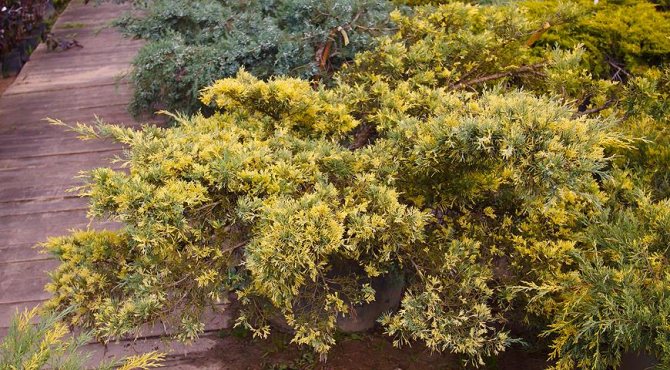
Pfitzer Juniper or Medium Blue and Gold (Blue Gold)
Pfitzer Juniper or Medium Carbery Gold
A low-growing shrub with a spreading crown and a golden shade of needles. The shoots are open, the ends are slightly hanging down.
Pfitzer Juniper or Medium Carbery Gold
Pfitzer Juniper or Medium Gold Coast
Shrub up to 1 m in height and up to 3 m in diameter, with a dense crown. The needles are yellow at the tops of the shoots, it gets dark in winter.
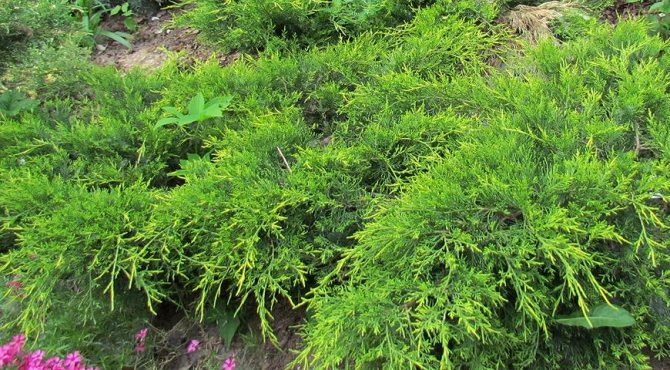

Pfitzer Juniper or Medium Gold Coast
Pfitzer Juniper or Medium Gold Star
Slow-growing shrub, up to 1 m high and up to 2,5 m in diameter. Golden needles.
Pfitzer Juniper or Medium Old Gold
Slow-growing shrub, up to 1 m high and up to 2,5-3 m in diameter. Scaly-needle needles, permanent golden color.
Pfitzer Juniper or Medium Old Gold
Pfitzer Juniper or Medium Pfitzeriana Aurea
A fast-growing shrub, up to 2,5–3 m high and up to 3,5–5 m in diameter. The crown is prostrate, raised over time. The needles are scaly and needle-like, yellowish-golden on young shoots, later turning green.
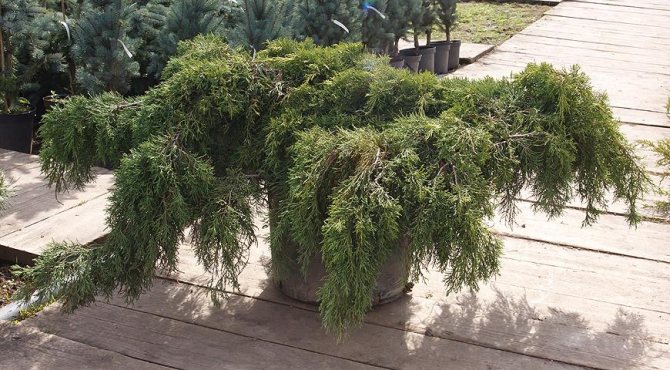
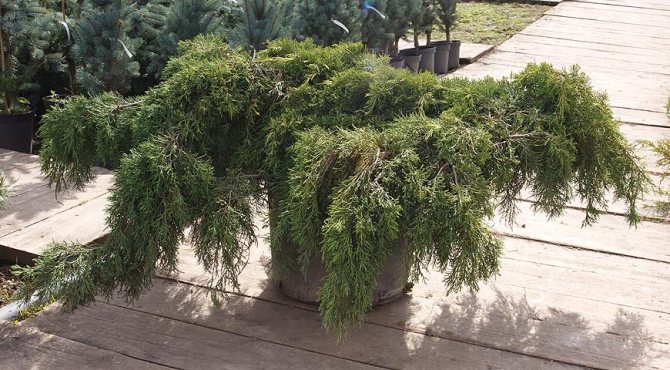
Pfitzer Juniper or Medium Pfitzeriana Aurea
Pfitzer Juniper or Medium Pfitzeriana Glauca
Shrub up to 1,5 (2,5) m in height and up to 3 m in diameter. The needles are bluish-green.
Features of planting and care
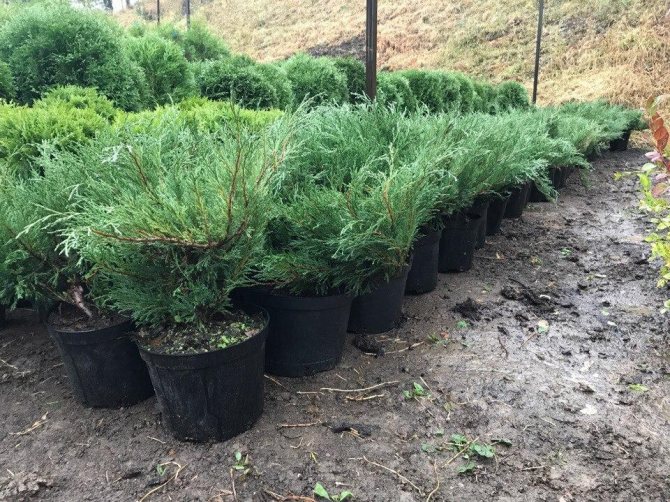
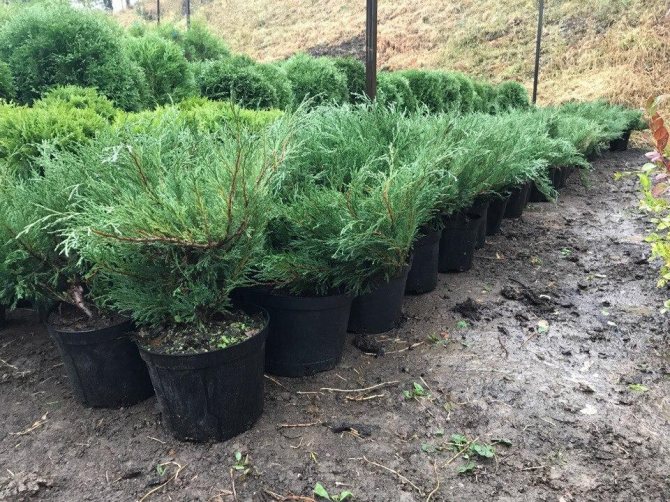
Most varieties prefer open sunny areas, tolerate light shading.
The Cossack variety is considered undemanding, but it is important to select the place of cultivation in accordance with the characteristics of a particular plant. Most varieties prefer open sunny areas, tolerate light shading. Inadmissibly close flow of groundwater, location in a lowland, in flooded areas.
High resistance to gas pollution and smoke will make it possible to cultivate this juniper not only within the city, but also to be located close to industrial enterprises and highways. When choosing a site, one should take into account the soil-protective properties of the species, the permissibility of planting on slopes and stony soils.
Landing
The procedure is carried out using the spring transshipment method. It is permissible to transfer container-type seedlings into open ground during the active growing season. The landing pit is prepared in advance. The dimensions of the dug hole should be 2-3 times larger than the earthen lump on the root system of the Cossack juniper. If the soil is too heavy, pour about 20 cm of a drainage layer of broken brick or crushed stone and coarse sand on the bottom.
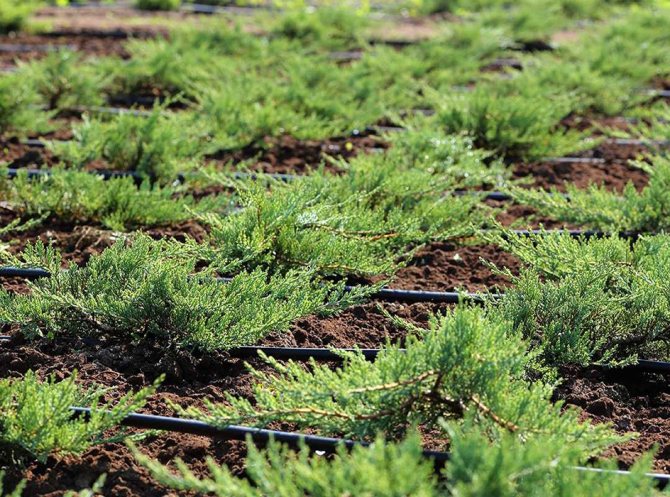
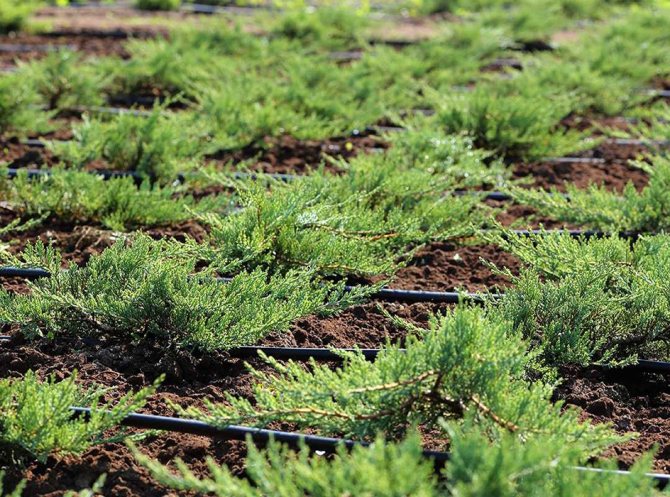
The procedure is carried out using the spring transshipment method.
The soil mixture should be prepared from sod land, high peat and river sand, taking these components in a 1: 2: 1 ratio. It is recommended to add dolomite flour or wood ash, compound fertilizer. Pour the prepared composition on the drainage, then put the juniper with the preserved earthen lump so that the root collar is not buried, exceeding the soil surface by 5 cm.Fill the formed gaps with soil mixture, draw a near-trunk circle, water abundantly. When the water is completely absorbed, the surface of the earth is mulched with pine bark, rotted compost or peat.
Care
For some time after planting, the Cossack juniper should be more carefully looked after. Water the first week, sprinkle the crown, shade from direct sunlight. Some varieties may have differences in agricultural technology, which must be considered when buying a seedling.
Basic care for this coniferous species includes:
- watering during severe drought;
- sprinkling of the crown;
- weeding;
- loosening a dense earth crust;
- periodic moderate feeding;
- sanitary, forming pruning;
- insulation for the winter;
- protection from diseases and pests.


Moisten the crown in a drought by sprinkling once a week in the evenings.
Watering the Cossack species of juniper is enough 2-3 times during the summer, provided there is a strong heat and no rain. Moisten the crown in a drought by sprinkling once a week in the evenings. When a dense crust forms on the soil surface, loosen it, since the horse system must receive a sufficient amount of air. Remove weeds immediately so that they do not take food from the juniper.
Feed from the second year after planting. The procedure should be carried out in the spring, combined with watering, use a solution of universal fertilizer for conifers. At the beginning of the growing season, it is necessary to inspect the crown of the Cossack variety, remove all damaged shoots. Fast-growing varieties are recommended to be subjected to formative pruning, which allows you to stop growth and give the plant the desired shape.
To reduce the negative effects of winter, the bush is being prepared in late autumn. It is necessary to do water-charging irrigation and mulch the near-trunk circle with a thick layer of peat or other natural material. In the spring, it is imperative to remove the mulch so that the root collar does not rot. Varieties that tend to break off under the weight of snow, it is advisable to tie, burn under the rays of the sun in February – March, cover with spruce branches or burlap.
Juniperus squamata
A dioecious, less often monoecious creeping shrub, grows naturally in the mountainous regions of East Asia. The needles are needle-like, very tough. Oval cones are black, glossy.
Juniper scaly Blue Carpet
Popular Dutch variety. Creeping shrub, 0,3–0,5 m high and 1,5–2,5 m in diameter. The needles are blue, sharp, but not prickly.
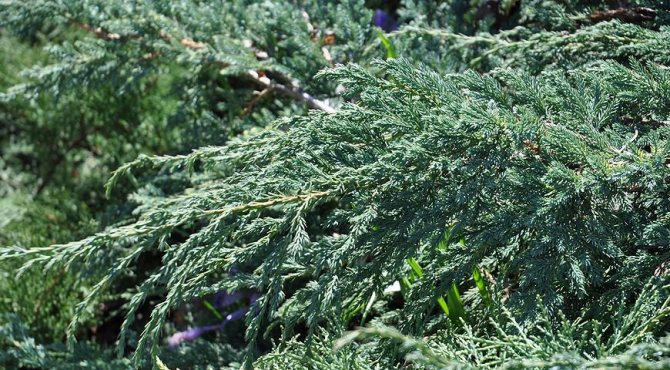
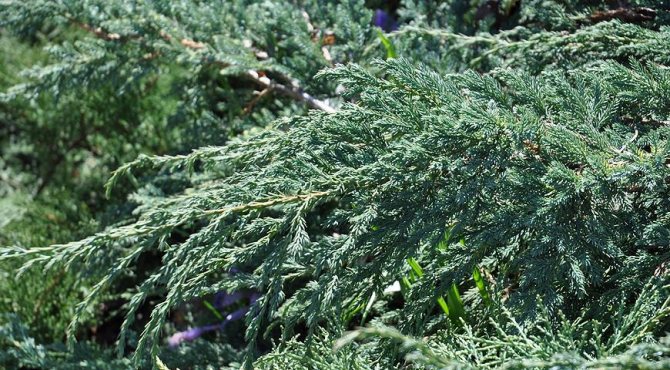
Juniper scaly Blue Carpet
Juniper scaly Blue Star
Dwarf slow-growing shrub, up to 0,5 m in height and up to 1,5 m in diameter. The needles are silvery-blue.

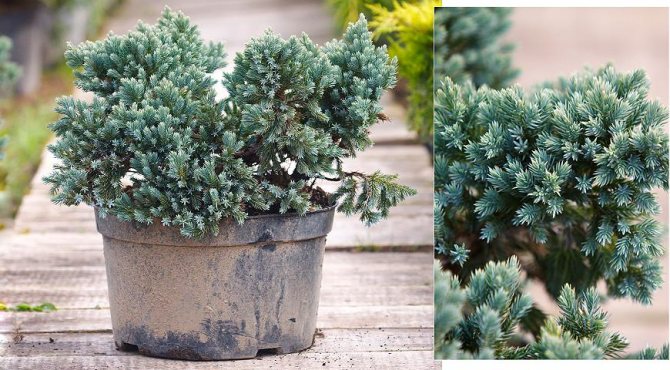
Juniper scaly Blue Star
Juniper scaly Floreant
Slow-growing shrub, up to 0,5-1 m high and up to 1,5 m in diameter, with a spherical crown. The needles are blue with light creamy splashes.
Juniper scaly Holger
Moderately growing shrub, up to 1 m high and up to 1,5 m in diameter. Young growths are yellow, then turn bluish. The color of the needles is brighter in sunny areas.
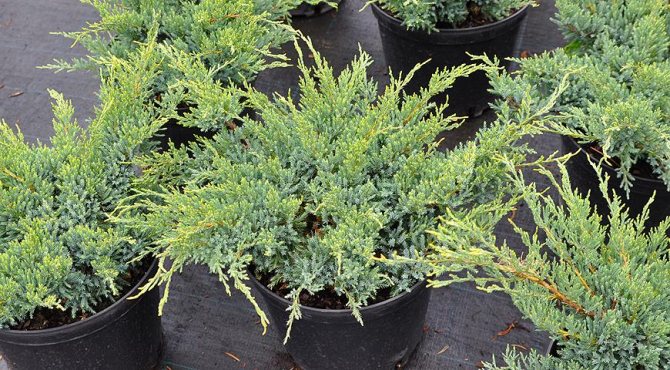

Juniper scaly Holger
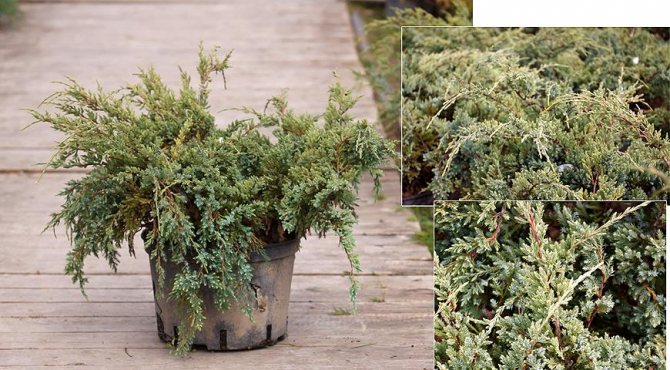
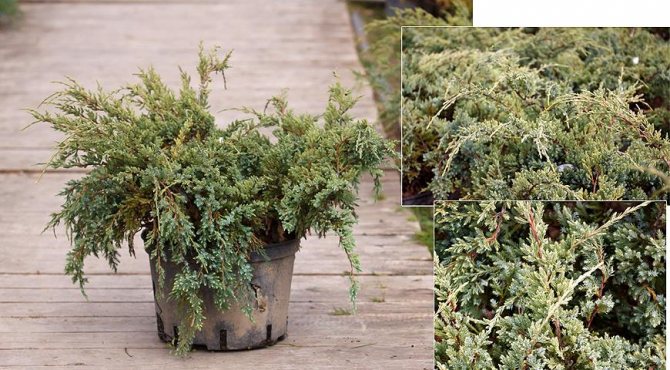
Juniper scaly Holger
Juniper scaly Meyeri
Erect shrub. The needles are silver-blue.
Features of planting junipers
Juniper seedlings: selection rules
The choice of planting material is very important: in the case of juniper, seedlings with ZKS (closed root system) are preferable. Junipers with ACS can be planted for a very limited time – in April-May or at the end of August-September in moderately humid weather. When buying, carefully examine the needles. At the slightest sign of her illness, it is better to refuse to purchase.
Place for juniper
Junipers are planted in sunny places, in the shade they can grow shapeless and loose. At the same time, decorative brightly colored varieties can lose all their advantages. Able to transfer some shading only m. Ordinary.
Landing pit
The distance between plants should be at least 0,5 m for medium-sized and short ones, up to 2 m for tall forms. The depth of the planting hole depends on the size of the earthen coma and the root system of the plant. Usually, junipers are planted in a hole, the size of which is 2-3 times the size of the coma. For large bushes – 70 cm deep.
At the bottom of the pit, it is imperative to make a drainage layer of broken brick and sand 15–20 cm thick. And fill the roots with a soil mixture consisting of peat, turf and sand in a ratio of 2: 1: 1.
Before planting, all container plants must be impregnated with water, holding the earthen lump for about 2 hours in a container with water. Large plants are planted so that the root collar is 5-10 cm above the edges of the planting pit. In young plants, it should be at ground level.
The optimum acidity of the soil is from 4,5 to 7 pH, depending on the type and variety. For the Cossack juniper, liming is useful – dolomite flour is added before planting on heavy soils.
Landing
The Chinese variety of juniper is characterized by a fairly good ability to withstand unfavorable factors in adulthood. Young seedlings can die if the plant is improperly planted or placed in the wrong place on the site. Coniferous species do not tolerate transplantation well. Planting material is recommended to be purchased in specialized reserves or garden centers. Otherwise, there is a risk that the varietal characteristics of the juniper will not be preserved or the bush will quickly lose its decorative effect.
On a note! The root collar cannot be buried, since rotting and death of the tree is possible.
Optimal planting time
It is recommended to transfer coniferous species to open ground in spring, so that the seedling has time to take root before the onset of cold weather. The Chinese variety can be planted in September, but should be more carefully insulated for the winter. In this case, the plant may slow down the growth and development a little. Regardless of the season, it is allowed to plant container juniper with a closed root system.
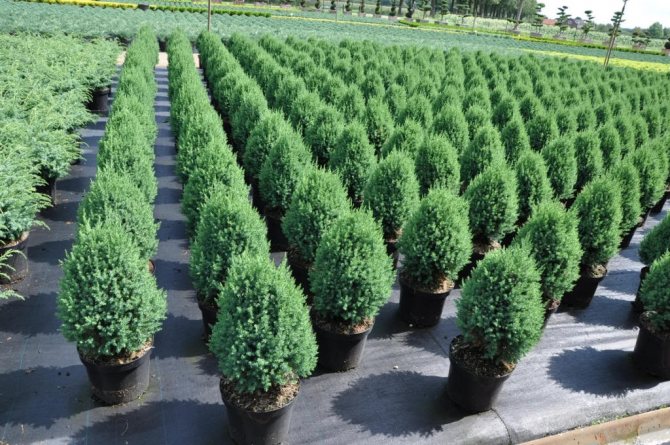
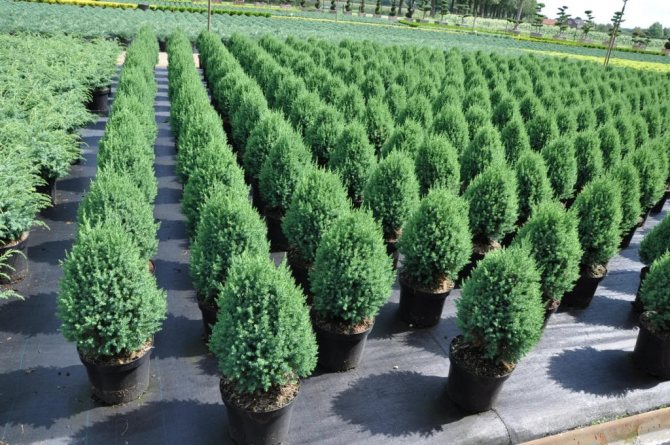
It is recommended to transfer coniferous species to open ground in spring, so that the seedling has time to take root before the onset of cold weather.
Site Selection
Most varieties of the Chinese variety require good lighting. In the shade and partial shade, a decrease in decorativeness and immunity is possible, the crown becomes rare, loose. For this reason, the juniper should be placed in an area open to the sun. If possible, choose an area protected from drafts, strong winds and waterlogging, since exposure to unfavorable factors will lead to the death of the plant.
Landing scheme
Carrying out the procedure in accordance with agrotechnical recommendations will ensure the survival of the seedling in a new place in a short time.
Planting Chinese juniper step by step:
- Prepare a planting hole in 2 weeks: dig a depression 3 times larger than the rhizome of the plant. If the soil is heavy, clayey, you need to pour a drainage layer of sand and broken red brick on the bottom. Next, fill the hole with a soil mixture of high peat, turf and coarse sand.
- Water the container seedling abundantly, additionally treat the bush without an earthen coma with a growth stimulator solution, disinfect.
- Make a depression in the prepared hole corresponding to the size of the earthen ball on the root system.
- Transfer the seedling, add nutritious soil if necessary.
- Sprinkle abundantly.
- For the next 2 weeks, make sure that the earthen lump does not dry out.
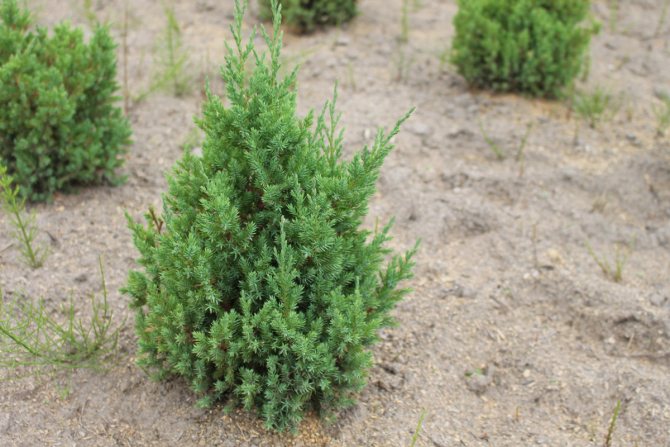
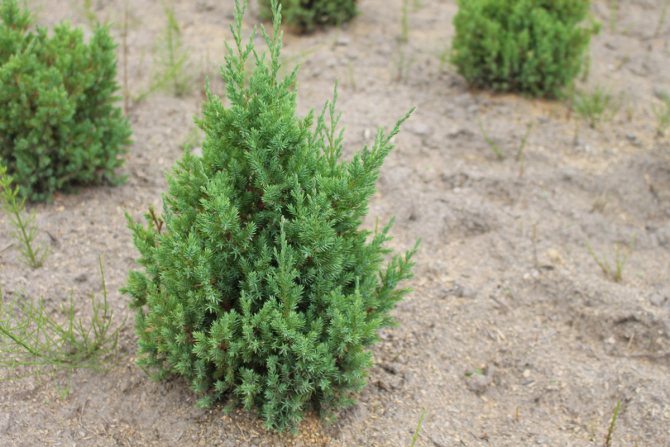
The juniper should be placed in areas open to the sun.
Features of care for junipers
Feeding
Junipers are undemanding to the soil. All they need is to apply nitroammofoska (30–40 g / m2) or universal granular fertilizer (20 g per 10 l of water) in April-May.
Watering
Junipers are watered only in dry summers, and even then infrequently – 2-3 times per season. The watering rate is 10–30 liters per adult plant. They can be sprayed once a week, certainly in the evening.
Junipers ordinary and Chinese do not tolerate dry air. Juniper Virginia is drought-resistant, but grows best on soils of medium moisture.
Caring for junipers immediately after planting
Young plantings of junipers need loosening – shallow, after watering and weeding. Immediately after planting, the soil is mulched with peat, chips, pine bark or pine nut shells, the thickness of the mulch layer is 5–8 cm. Heat-loving cultivars are mulched for the winter, and in early spring the mulch must be raked off, as it can cause rotting of the root collar.
Trimming
Due to their slow growth, junipers are pruned very carefully. Mostly dry branches are removed at any time of the year.
Preparation for winter
Only young plants are sheltered for the winter, and then only in the first year after planting.

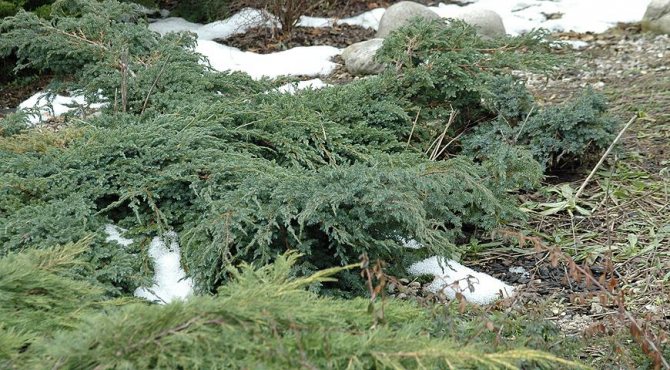
Reproduction of junipers
You can propagate juniper by seeds and cuttings.
In culture
Juniper bonsai Chinese
It is very common in China and Japan. Introduced to Western Europe in 1804, common in culture. In the CIS, it has been cultivated in the Nikitsky Botanical Garden since 1850. It is often found in the parks of the South Crimea and the Caucasus, where it grows and bears fruit quite well. In southern Crimea, it suffers from drought. In Ukraine, it is found in Odessa, Kiev .. The Chinese juniper has long been used to form bonsai.
It grows slowly at first. Relatively hardy. Withstands -25 … -30 ° С. It withstands the conditions of arid steppe well, it develops better on deep fresh soil with sufficient air humidity farmer-online.com. Frost resistance zones: from 5a to warmer. In some years, in the conditions of the Moscow region, plants can freeze out, which manifests itself in the form of frostbites on individual branches, browning and drying of needles and branches farmer-online.com. In the first years of life, the tips of the shoots often freeze in the Chinese juniper, with age the frost resistance increases ..
Regions of application: the south-western part of the forest zone, the western and central parts of the forest-steppe and steppe zones of the European part of the CIS, Crimea, the Caucasus farmer-online.com.
It is not very demanding on soil fertility and moisture, but it does not tolerate dry air. It develops well in city conditions.
Reproduction: seeds and cuttings ..
Juniper design
Junipers are widely used in landscape design: soft (in most species) needles of various colors, delicate aroma, undemanding growing conditions – these are the reasons why most gardeners and designers are very disposed towards them.


Junipers are planted in alleys, grown on alpine hills and in rockeries. At any time of the year, they are good in garden compositions with other conifers: spruce, pine, thuja, fir and hemlock. In spring and summer, their greenery, blueness or, conversely, yellow color emphasize and set off the beauty of rhododendrons and hydrangeas, magonia and heathers and numerous bulbs: tulips, daffodils, hyacinths, etc.
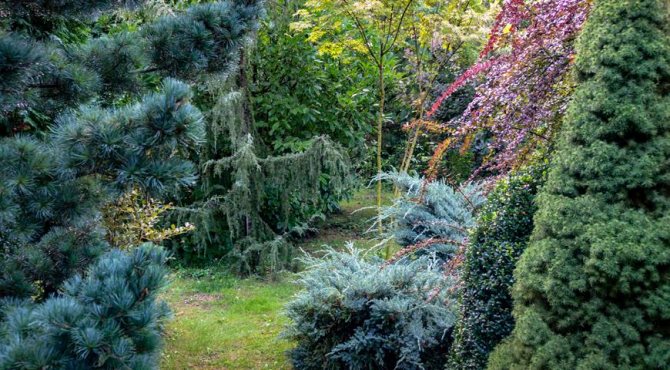
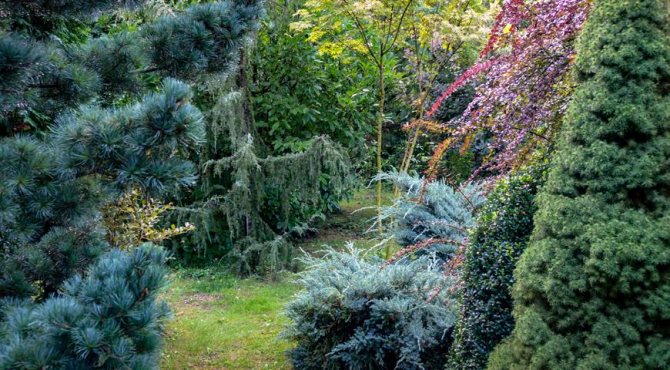
The use of Chinese juniper in landscaping
Such a bush is very popular in landscape design, since it is easy to modify. The plant will find a place in rockeries, hedges.
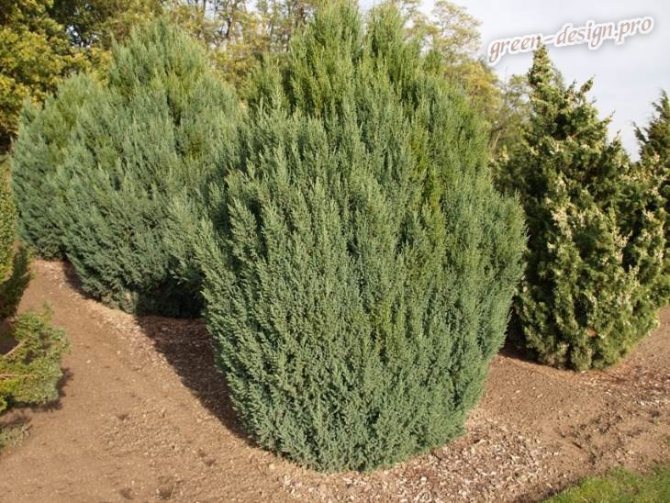
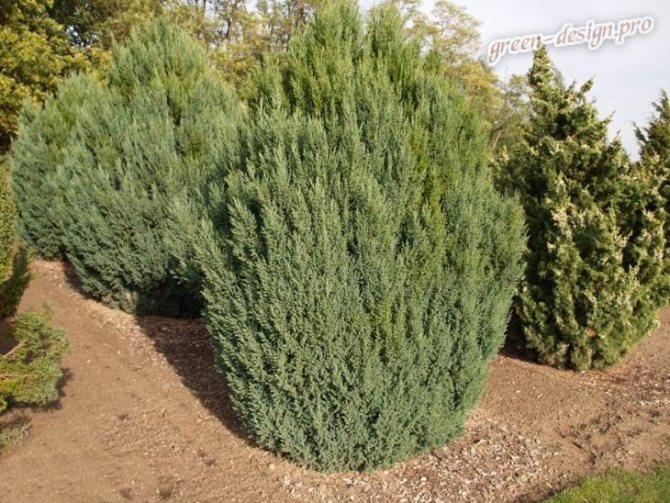
Juniper Chinese Strickta in group planting
Can act as a tapeworm on lawns. Bulbous flowers such as daffodils or hyacinths can be planted next to the crop.
Also a popular solution among oriental gardeners is to grow a crop as a bonsai, forming the original curves of the trunk.
